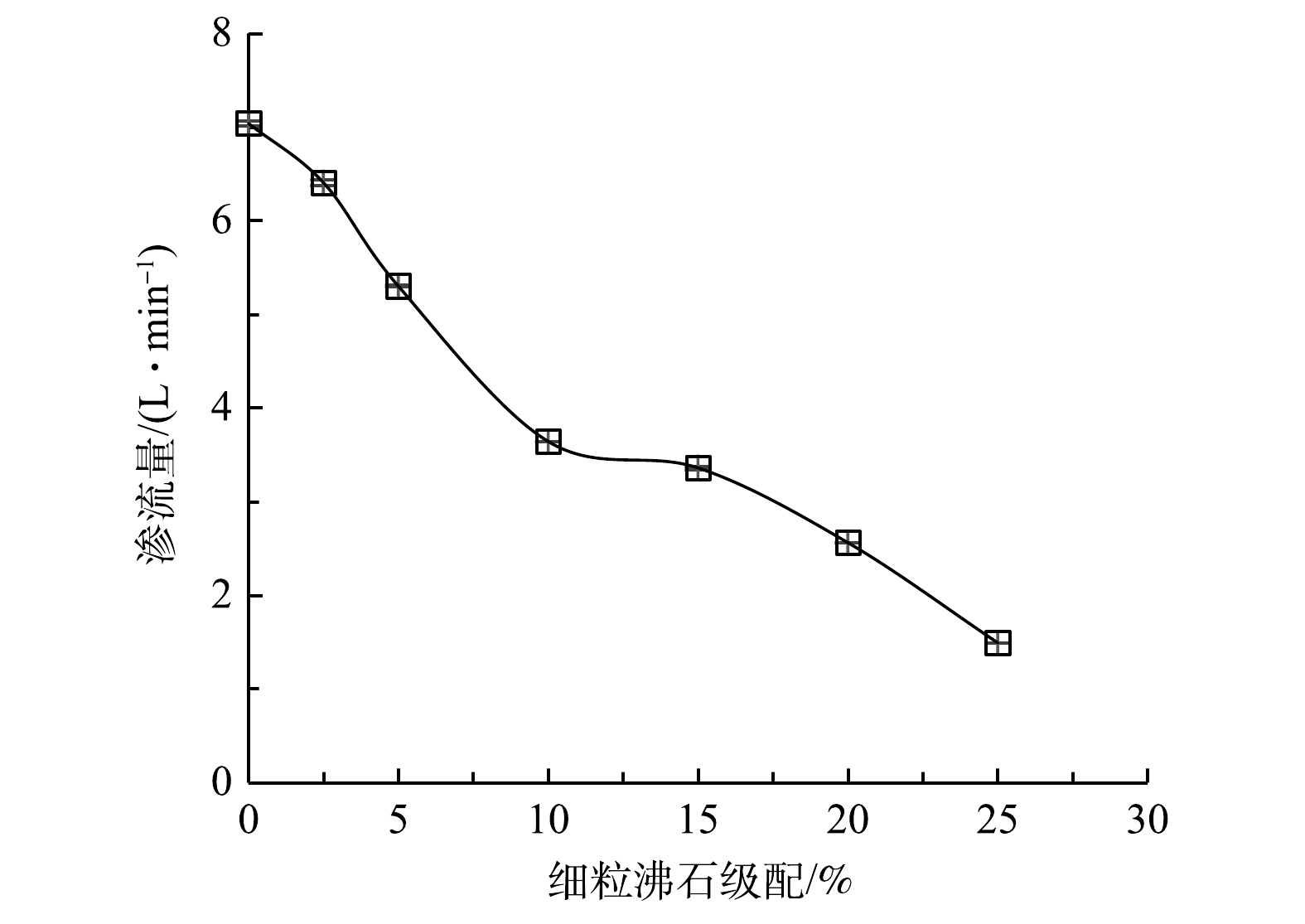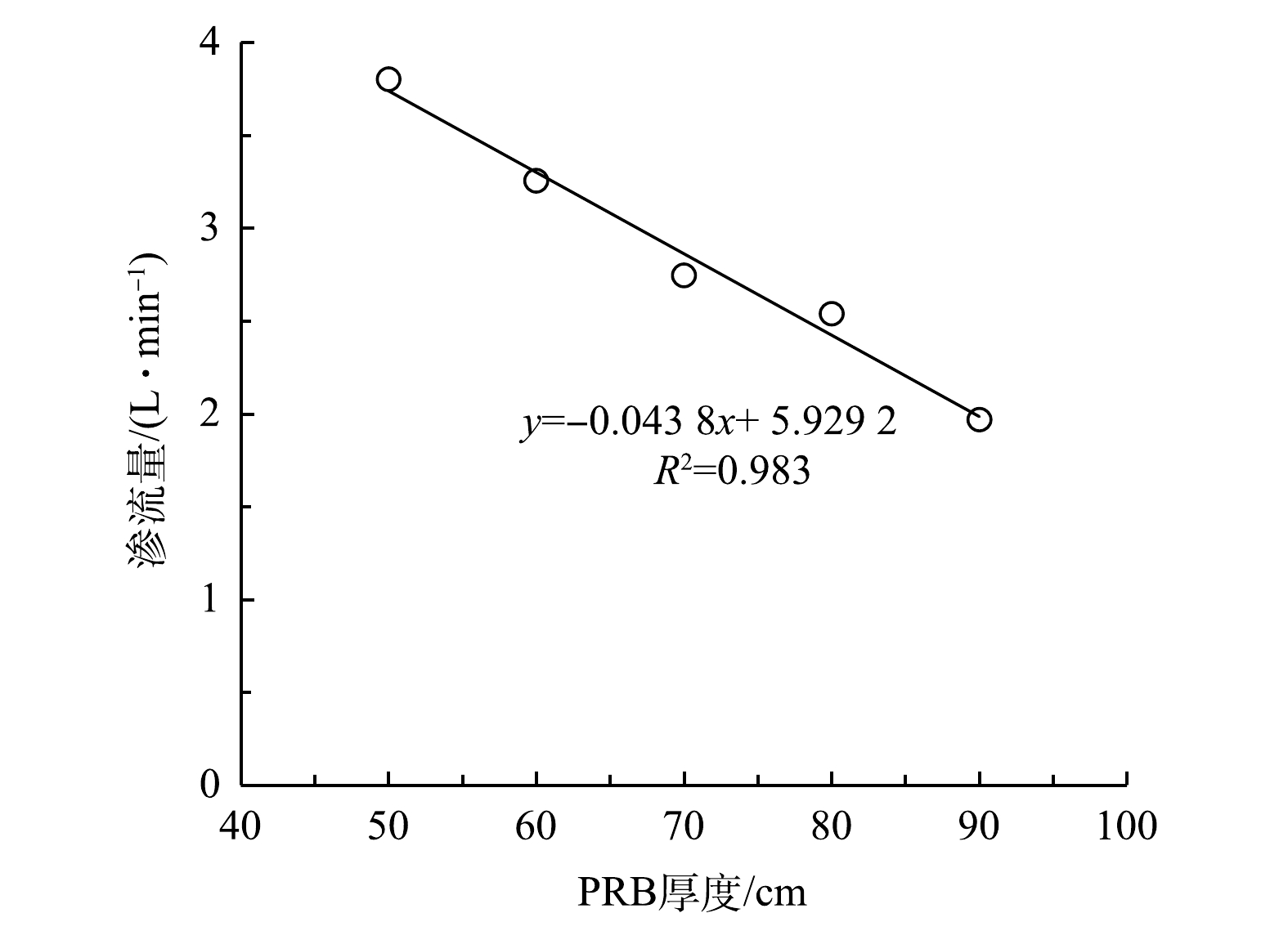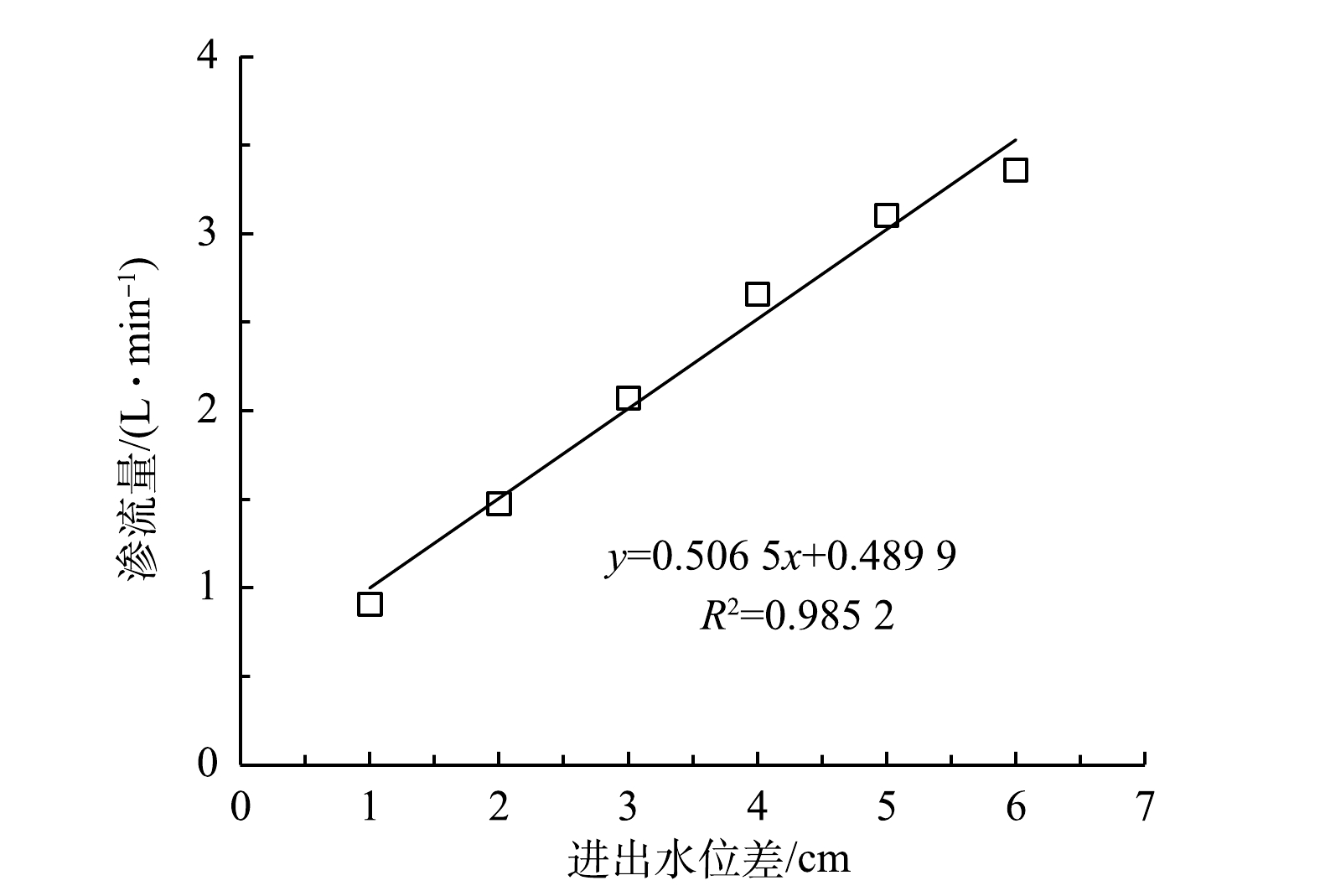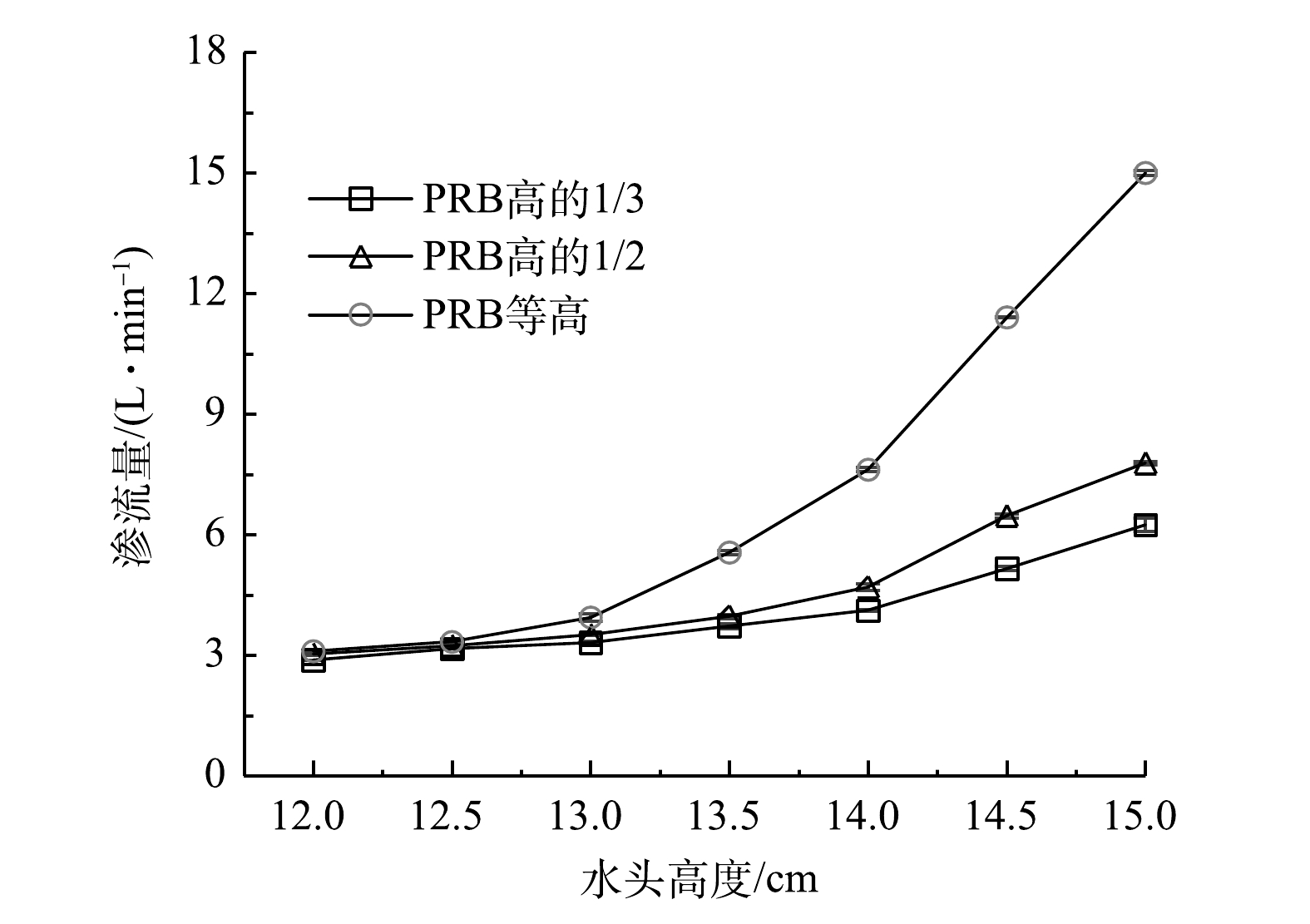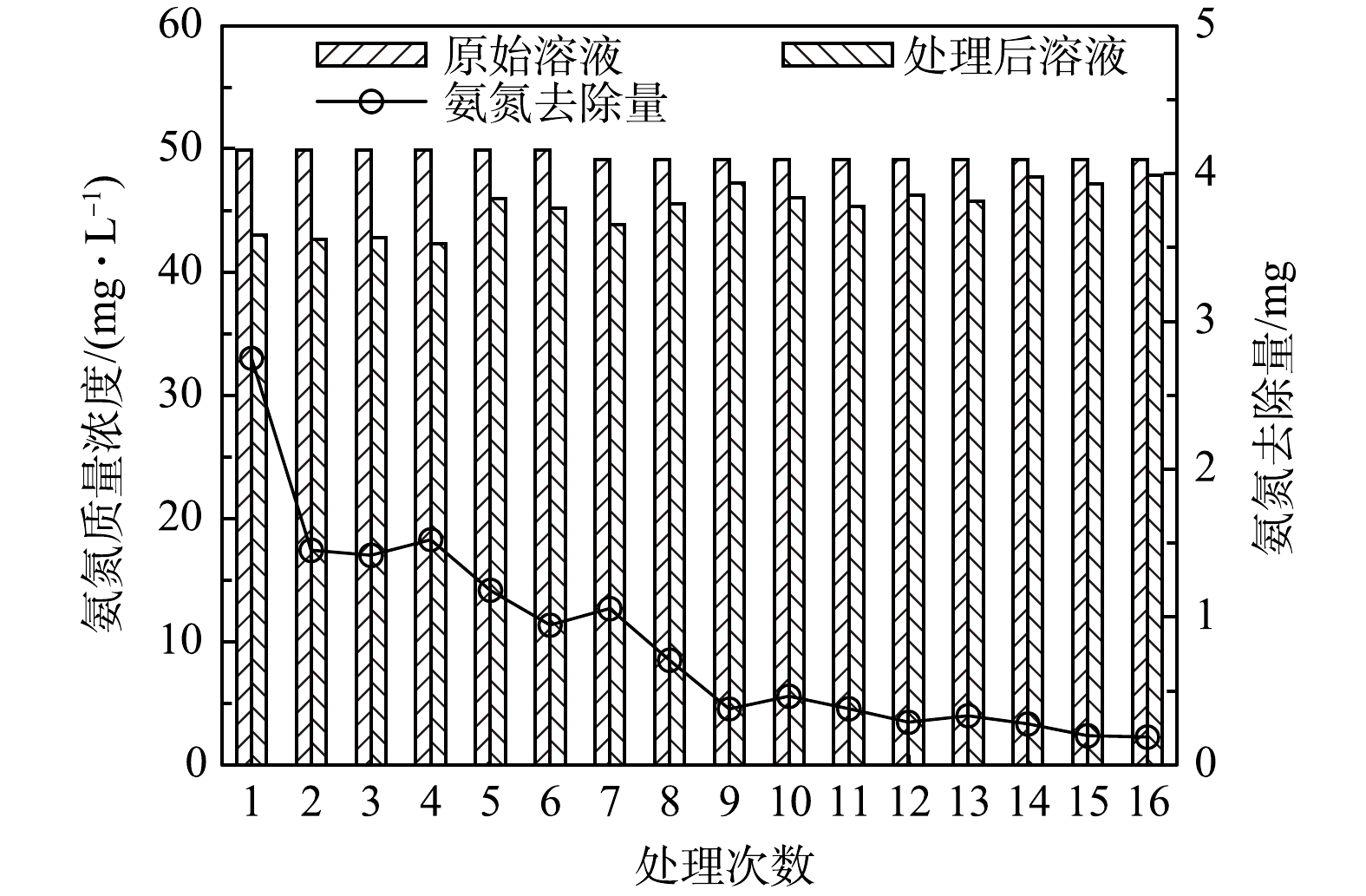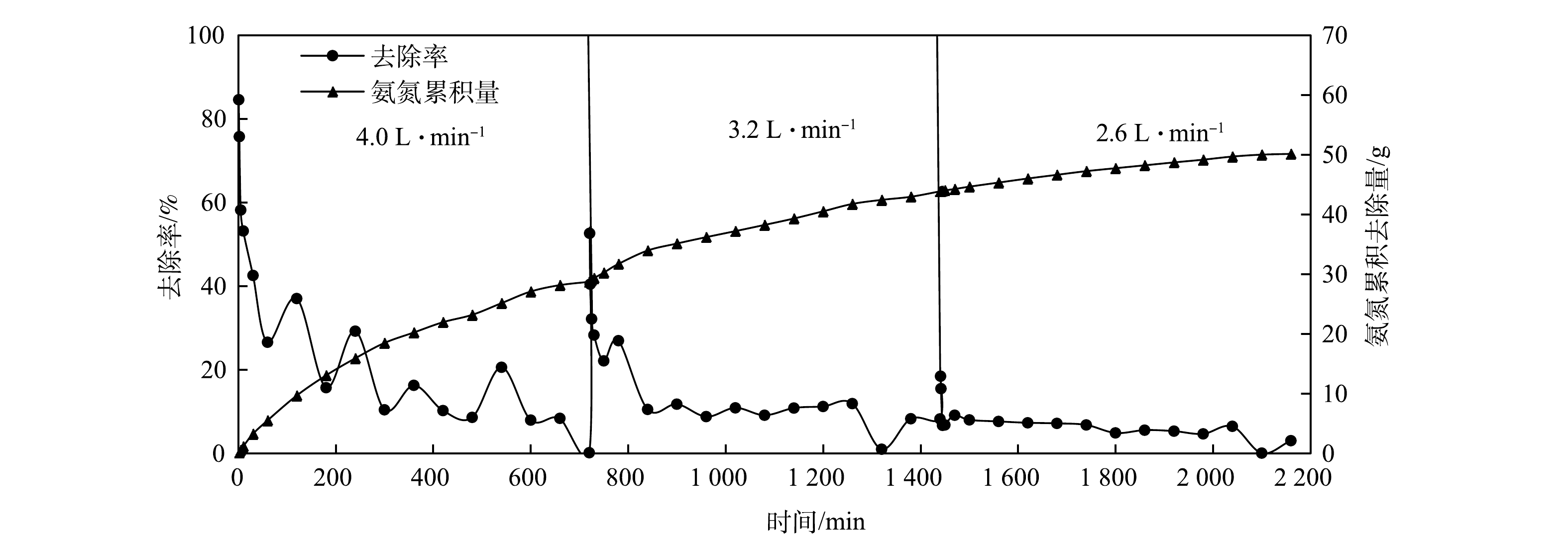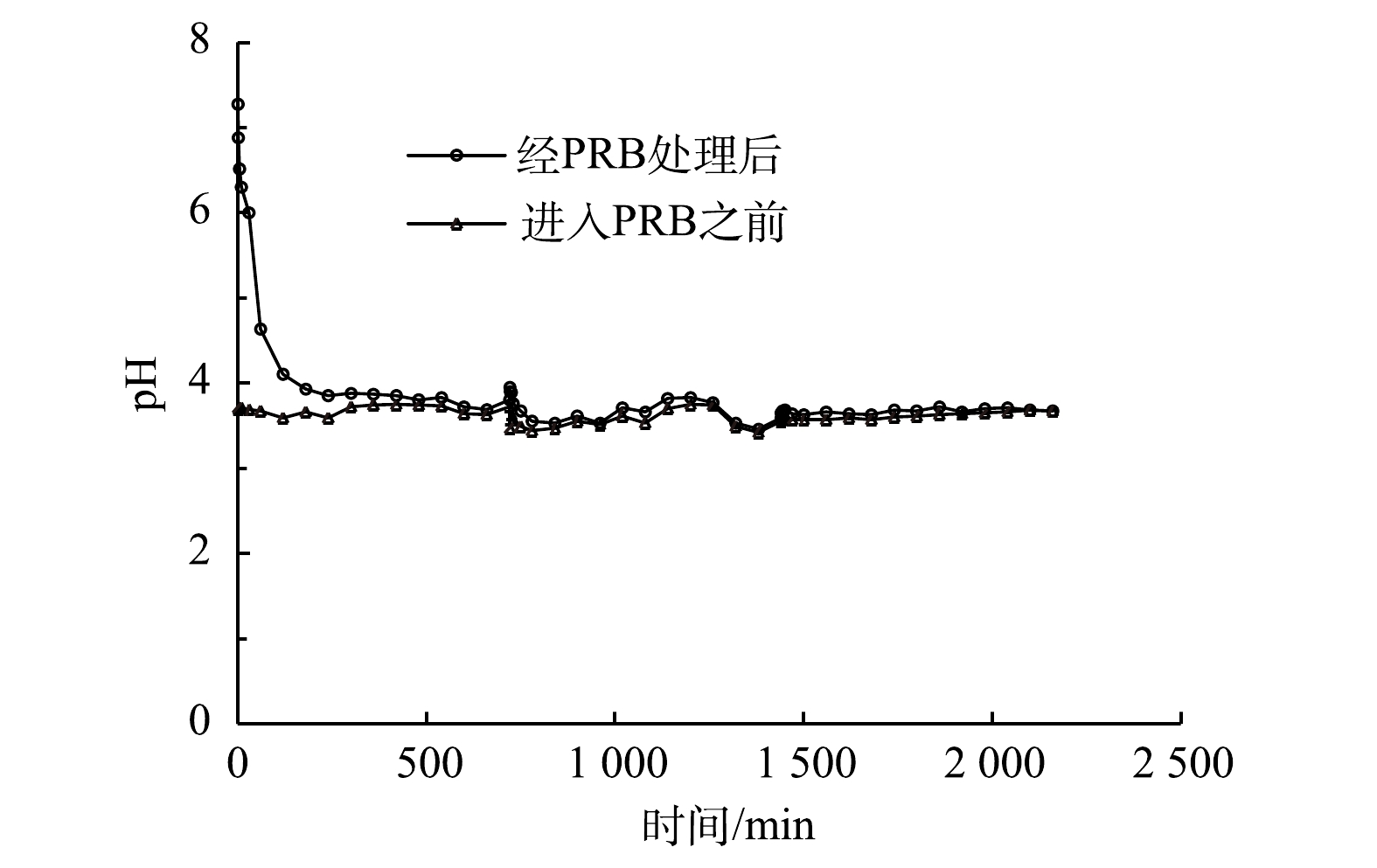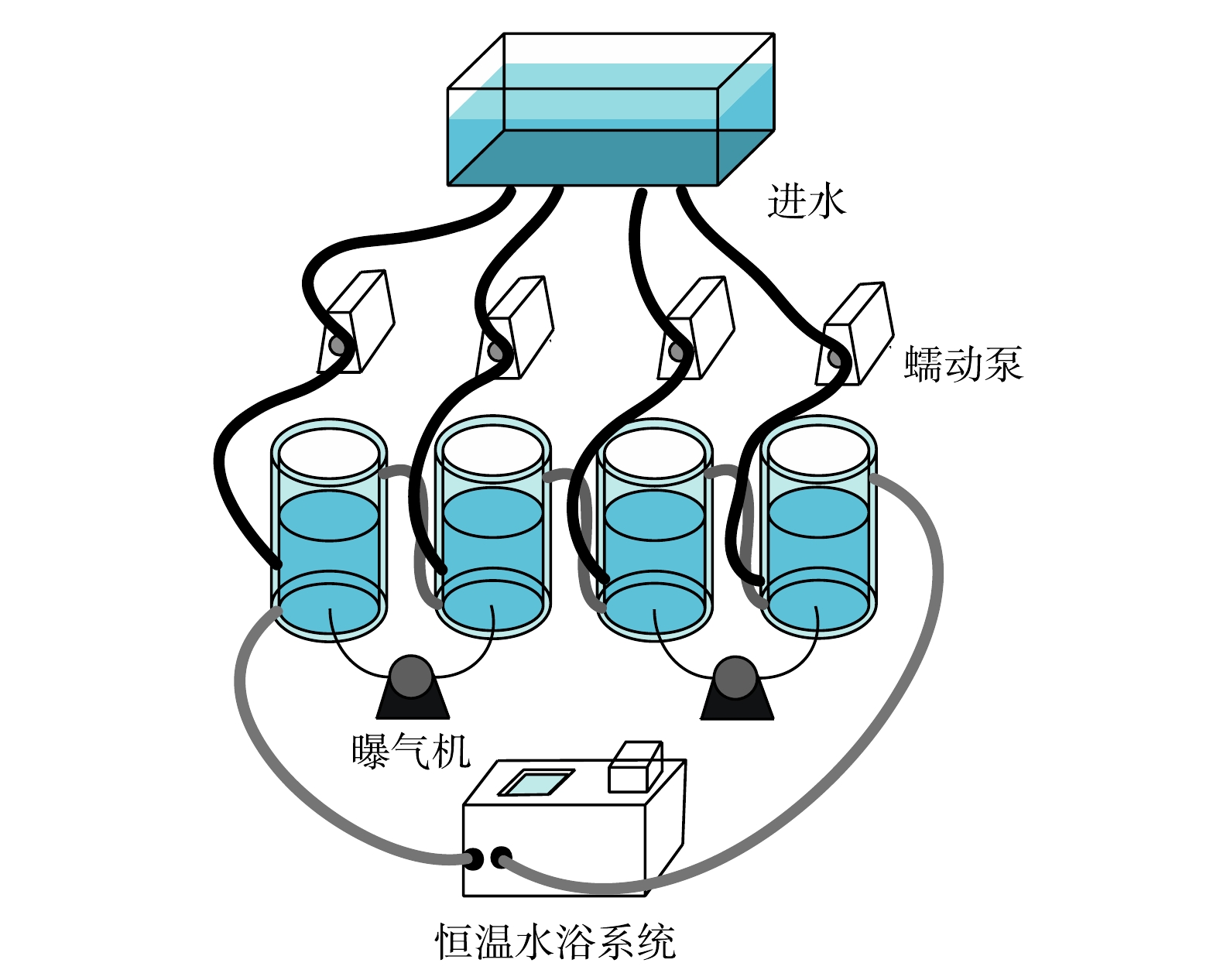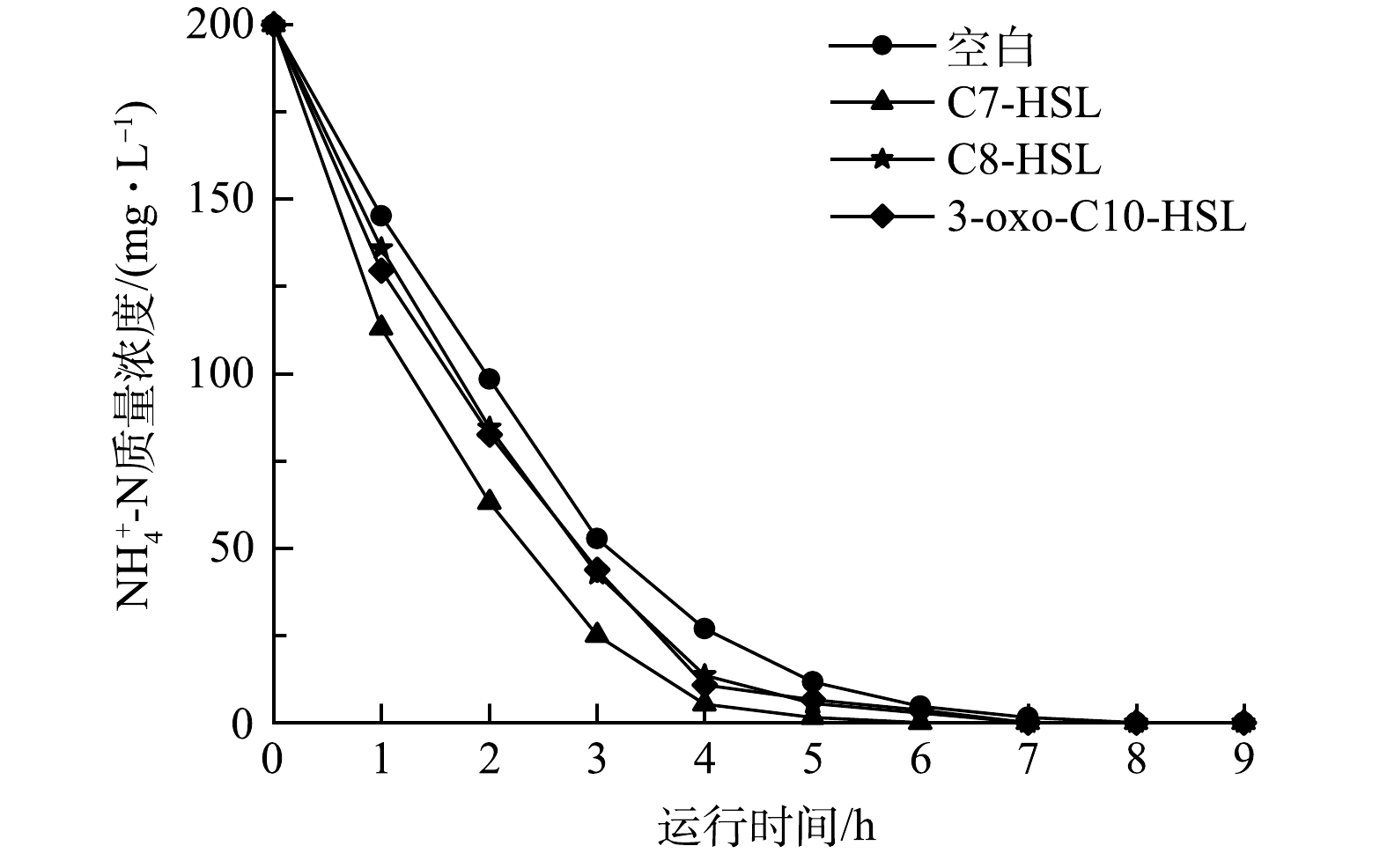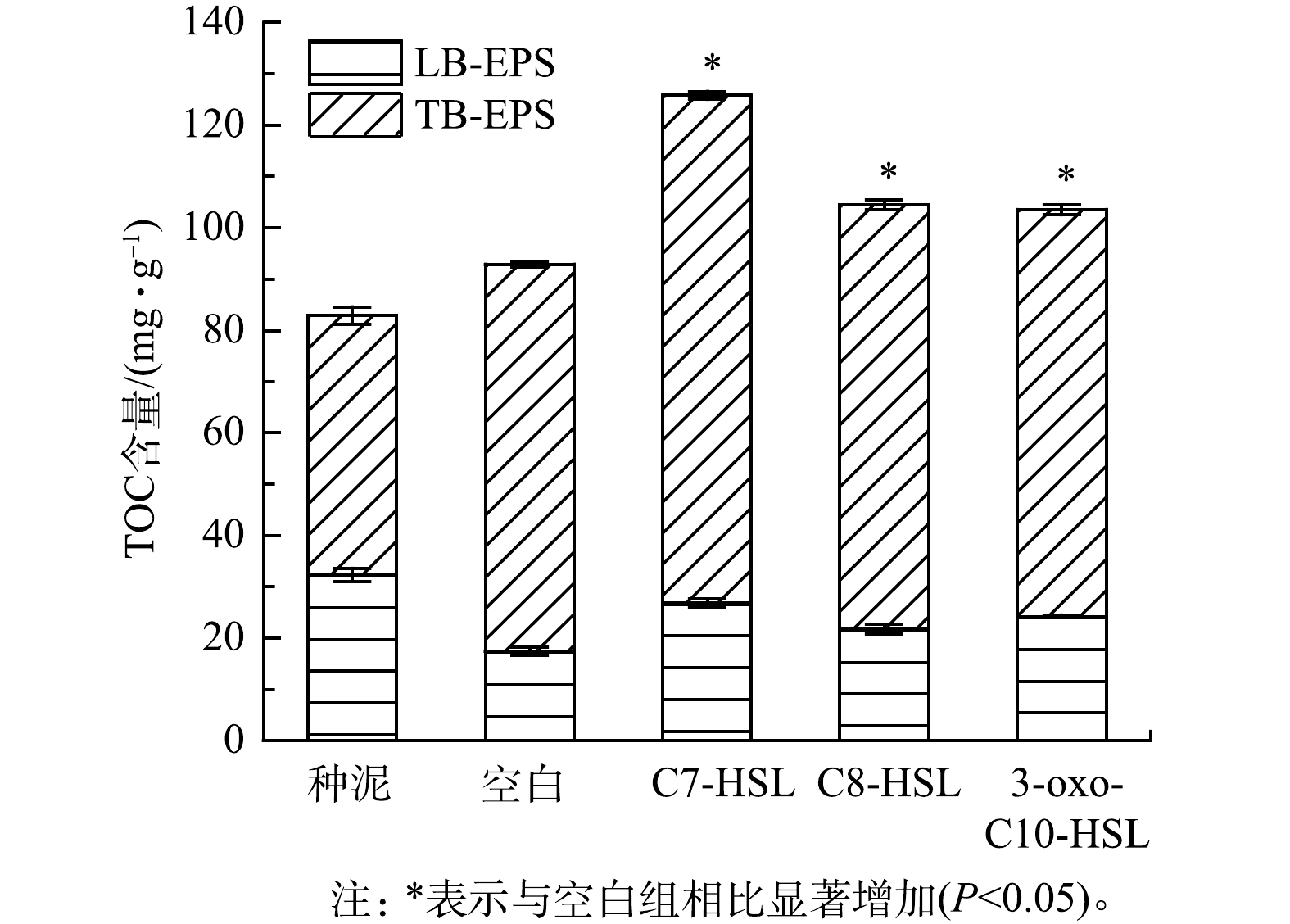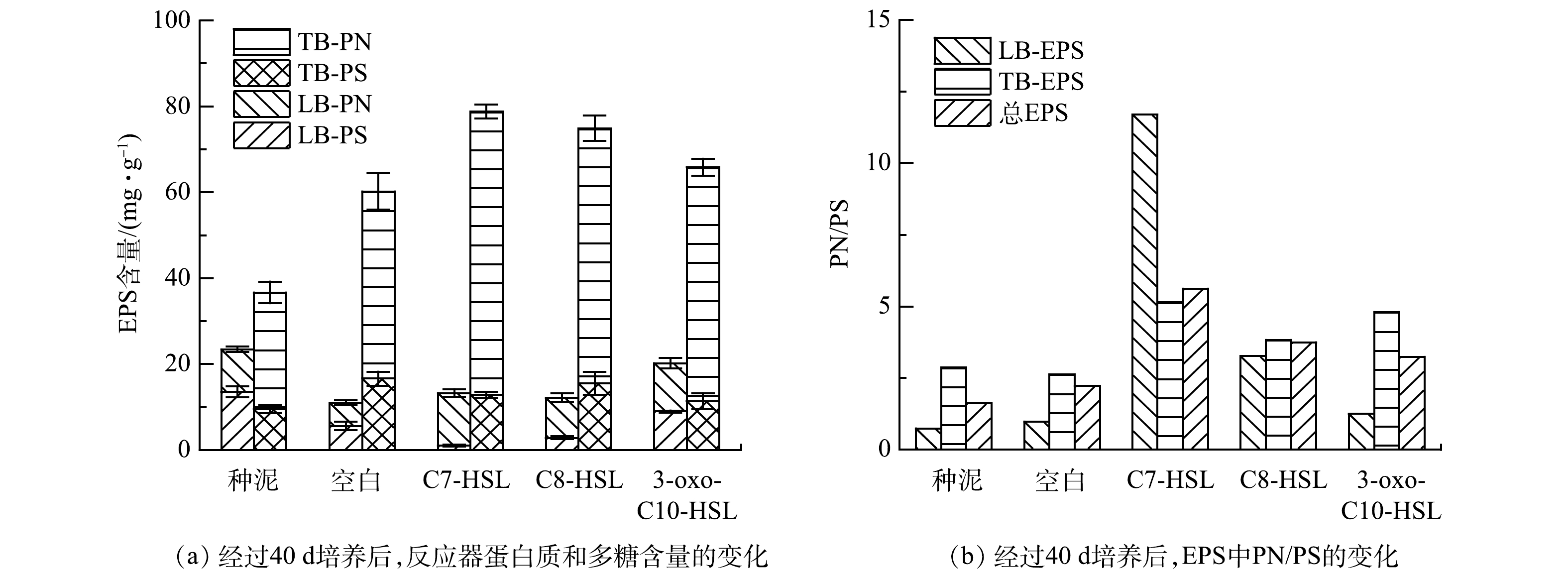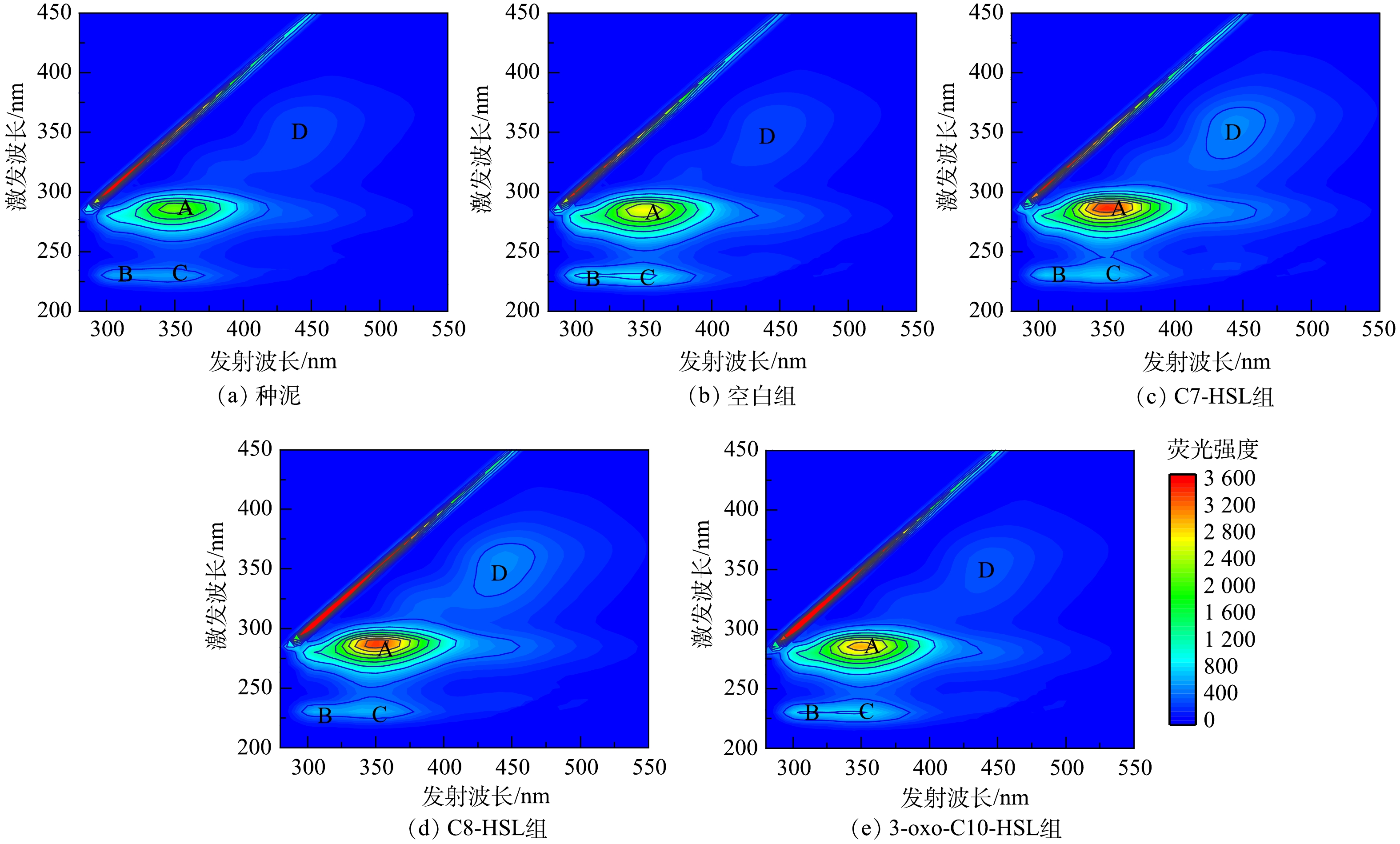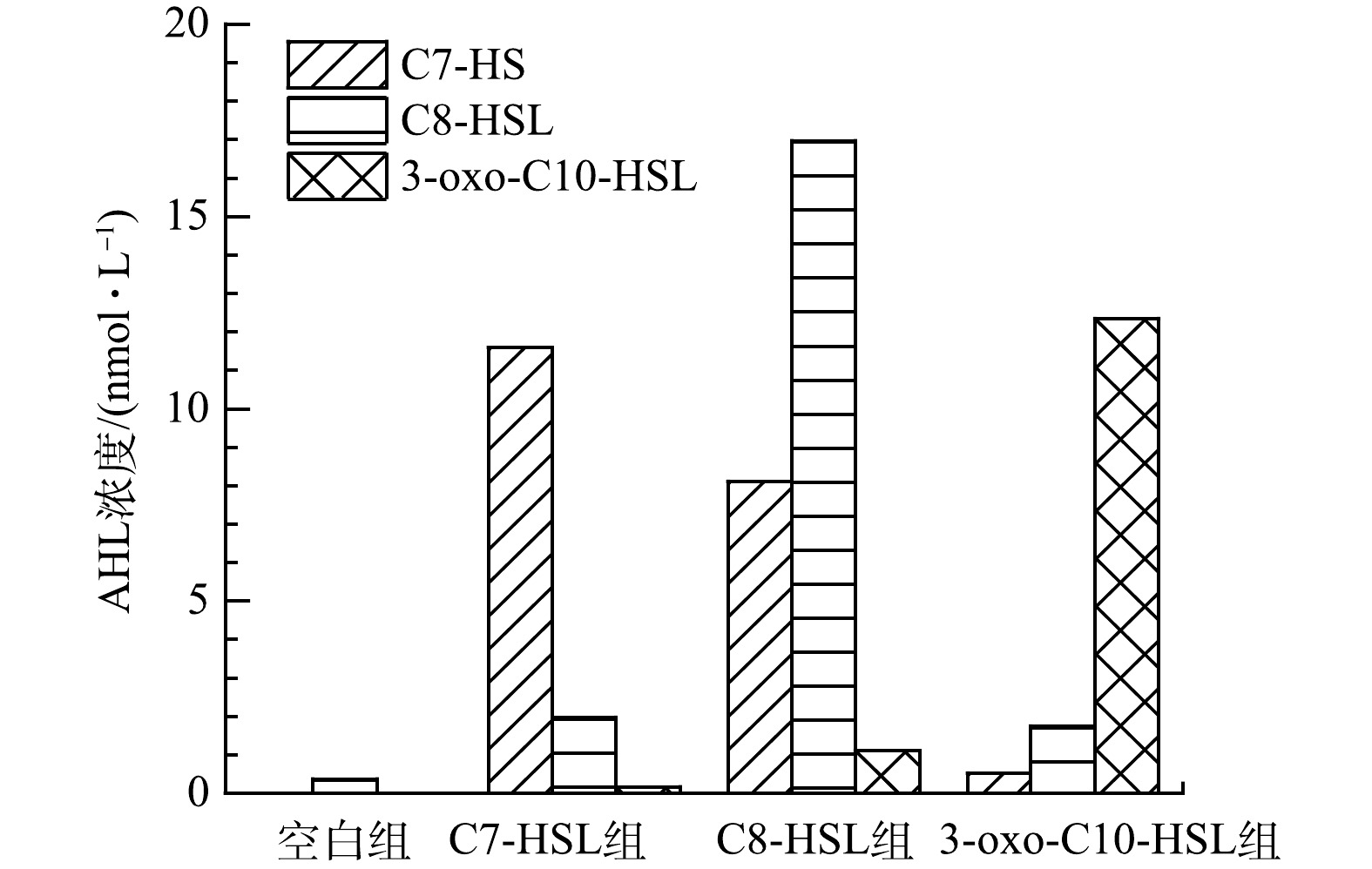-
氨氮作为水体中的主要污染物之一,容易使水体富营养化,导致“水华”和“赤潮”发生,严重威胁生态环境[1]。硝化和反硝化作用是生物脱氮的两个重要步骤。硝化作用是在好氧条件下氨氧化细菌(ammonia-oxidizing bacteria,AOB)和亚硝酸盐氧化细菌(nitrite-oxidizing bacteria,NOB)将氨氮转化为亚硝酸盐和硝酸盐的过程,反硝化作用是通过反硝化细菌将硝酸盐和亚硝酸盐还原成气态氮的过程。生物脱氮因经济高效、易于操作和绿色无二次污染等优点成为研究热点。但是,由于硝化细菌生长缓慢、同化效率低和环境敏感性高,并且高氨氮废水中存在大量的游离氨会对传统生物脱氮法中的微生物活性产生抑制作用,因此,保持细菌的活性,维持生物量是影响脱氮效率的关键因素[2]。
群体感应(quorum sensing,QS)是指微生物能自发合成并释放信号分子来感知周围细菌密度,当信号分子的浓度到达一定阈值后被细胞感知并调控相关基因的表达,从而调节微生物的一些行为,如生物膜的形成、生物发光和胞外多糖产生等[3-4]。已知的信号分子根据其化学种类的不同分为三大类:革兰氏阴性菌分泌的酰基高丝氨酸内酯(N-acyl-homoserine-lactones,AHLs)、革兰氏阳性菌分泌的寡肽(autoinducter peptide,AIP)和能同时调控革兰氏阴性菌和阳性菌实现细菌种间交流的呋喃硼酸二酯(AI-2)。酰基高丝氨酸内酯环是AHLs信号分子的共同特征,酰基侧链的长度、碳链骨架饱和度和取代基的不同导致了AHLs的多样性和特异性[5]。硝化功能细菌属于革兰氏阴性菌,种内产生的信号分子为AHLs,因此,本实验主要研究AHLs类信号分子对硝化细菌的影响。
1997年BATCHELOR等[6]首次发现Nitrosomonas europaea存在群体感应现象,其中高细胞密度培养比低细胞密度培养会产生和积累更多AHLs,并且外源添加3-oxo-C6-HSL信号分子有利于饥饿状态下的N. europaea恢复生长。最近的研究表明,硝化细菌可以通过QS调节自身的行为,例如提高细菌的活性、促进生物膜的生长以及调节胞外聚合物(extracellular polymeric substances,EPS)的合成,从而更好地聚集,占用更多资源和空间,保持环境中的种群优势[6-8]。在硝化反应器的混合培养中,投加不同种类的AHLs可发现,AHLs通过改变EPS的组成防止生长缓慢的硝化细菌流失,并且3-oxo-C6-HSL和C6-HSL有利于促进细菌的附着并提高脱氮效率[7]。同样,将硝化颗粒污泥中含有AHL的细胞提取物添加到硝化活性污泥中,处理30 d后,提高了细胞的粘附和聚集性,提高了微生物的活性,最大氨氮去除率提高了83.3%[8]。前期调研发现,C7-HSL是少见的酰基侧链C原子为奇数的信号分子且在污水处理中研究较少,而C8-HSL和3-oxo-C10-HSL是脱氮过程中的典型信号分子。因此,本研究添加C7-HSL、C8-HSL和3-oxo-C10-HSL到硝化系统中,通过观察污泥生长特性、硝化性能的变化以及EPS成分的改变,研究信号分子对处理高氨氮负荷污水的影响。
-
AHLs类信号分子N-Heptanoyl-L-homoserine lactone (C7-HSL)、N-Octanoyl-L-homoserine lactone (C8-HSL)和N-(3-oxodecanoyl)-L-homoserine lactone (3-oxo-C10-HSL) 购买自美国sigma-aldrich公司,并储存在−20 ℃。实验所用试剂无特殊说明均为分析纯。
-
本实验污泥取自武汉市沙湖污水处理厂二沉池,经曝气后添加到序批式反应器(sequencing batch reactor, SBR)中,并逐步提高氨氮浓度来驯化富集脱氮功能细菌。SBR的有效容积为18 L,循环周期为8 h(进水0.25 h,曝气搅拌6.5 h,静沉0.5 h,出水0.25 h,静置0.5 h),每周期进出水体积为9 L。接种初期,污泥总悬浮固体浓度(mixed liquor suspended solids,MLSS)为3.2 g·L−1,初始污泥沉降比(sludge settling velocity, SV)为24%,
NH+4 -N降解效率为69.65%。运行60 d后,进水NH+4 -N质量浓度从初始的30 mg·L−1逐步提高到200 mg·L−1,反应器中出水的NH+4 -N和NO−2 -N质量浓度均低于1 mg·L−1,而NO−3 -N逐渐累积,表明硝化细菌已成功富集。实验用水为人工合成污水,每次配水加入NaHCO3使pH维持在8.0~8.3,具体配方[9]见表1。 -
将SBR中的活性污泥分别接种到体积为1 L的4个SBR中(图1),分别为空白组、C7-HSL组、C8-HSL组和3-oxo-C10-HSL组,以相同条件运行40 d。恒温水循环系统设置为25 ℃,控制DO在2.0左右,进水pH维持在8.0~8.1,出水pH维持在7.0~7.1。每周期12 h(进水1 h,曝气搅拌9 h,静沉出水1 h,休息1 h),每周期进出水500 mL,每天排泥大约3%,进水配方见表1。初始MLSS为3.52 g·L−1,初始进水
NH+4 -N质量浓度为200 mg·L−1,在第5、9、15天分别提高NH+4 -N质量浓度至250、300、400 mg·L−1,每天分别加入0.5 μmol·L−1信号分子。每2 d监测出水NH+4 -N、NO−2 -N、NO−3 -N、TN,以及定时测量pH、蛋白质、多糖及TOC的浓度变化来分析各类信号分子对硝化活性污泥的影响。在反应器运行稳定后,第35天,每隔1 h测量反应器中NH+4 -N的质量浓度以分析信号分子对硝化污泥NH+4 -N降解的影响。 -
实验中MLSS、混合液挥发性悬浮固体浓度(mixed liquid volatile suspended solids,MLVSS)、出水悬浮物(effluent suspended solids,ESS)、TN、
NH+4 -N、NO−3 -N、NO−2 -N的质量浓度均按照《水和废水监测分析方法》测定[10]。TOC的测定采用TOC分析测试仪(multi N/C 2100,德国耶拿),DO和pH分别采用溶解氧仪(HQ40d,哈希)和pH计(PB-10,赛多利斯)测定。 -
EPS的提取采用高速离心法[11],分为松散结合型EPS (loosely-bond EPS,LB-EPS)和紧密结合型EPS (tightly-bond EPS,TB-EPS)。蛋白质的测定采用SK3501 BCA 改良型试剂盒(上海生工,中国)。多糖的测定为苯酚-浓硫酸法,具体方法参照DUBOIS等[12]的研究。TB-EPS的检测采用荧光光度计(F-7000 FL Spectrophotometer,日本)测量三维荧光光谱(fluorescence excitation-emission matrix, EEM),光谱设置条件如下:激发波长(Ex) 200~450 nm,步长5 nm;发射波长(Em) 280~550 nm,步长5 nm;狭缝宽度为5 nm,扫描速度2 400 nm·min−1。
-
利用固相萃取(solid-phase extraction,SPE)技术对样品中的AHLs进行浓缩,具体操作遵循LI等[13]的方法。AHL的检测参考胡惠秩[14]的方法。对于AHL定量,构建了5~100 nmol·L−1的基质匹配标准曲线,经计算C7-HSL、C8-HSL和3-oxo-C10-HSL的加标回收率分别为(98.82±4.21)%、(100.00±5.56)%、(97.65±6.85)%。
-
每次从每个反应器各取3个平行样,测量结果取平均值,用SPSS软件(R26.0.0.0)分析数据的差异性与相关性。游离氨(free ammonia,FA)与游离亚硝酸(free nitrous acid,FNA)可以表征其对NOB的抑制作用,FA和FNA一般根据式(1)和式(2)进行计算;在活性实验中,氨氮的消耗速率(
VNH+4 )按照式(3)进行计算。式中:CFA为游离氨质量浓度,mg·L−1;CFNA为游离亚硝酸质量浓度,mg·L−1;
Ct,NH3 为总亚硝酸盐质量浓度,mg·L−1;T为温度,℃。式中:
VNH+4 为消耗氨氮的速率,mg·(g·h)−1;CNH+4 为消耗氨氮的质量浓度,mg·L−1;M为污泥浓度,g·L−1;t为时间,h。 -
经过40 d的运行,4组SBR中的硝化污泥均得到了一定程度的增长。如表2所示,与空白组相比,添加了信号分子反应器的MLSS显著增加(P<0.05),增长率大约在20%~50%,其中C7-HSL组的MLSS增加的最多,达到(3.76±0.15) g·L−1,其增长量在1.24 g·L−1左右,大约是空白组增长量的5倍。出水悬浮物ESS可反映活性污泥的沉降能力与结构稳定性,实验组的ESS均比空白组低,空白组最高为0.035 g·L−1,C7-HSL组最低为0.025 g·L−1。计算MLVSS/MLSS可以反映硝化污泥中生物量的比例。结果表明,C7-HSL组的MLVSS/MLSS值最高,为0.764。比较各组平均生长速率(以MLSS计),实验组较空白组平均生长速率显著增加(P<0.05),C7-HSL组增加最明显,为(0.169±0.022) g·(L·d)−1,比空白组高出35.20%,C8-HSL组和3-oxo-C10-HSL组也明显高于空白组9.60%和10.40%。LI等[7]添加C6-HSL和3-oxo-C6-HSL,使得微生物的生长速率分别提高至0.260 g·(L·d)−1和0.227 g·(L·d)−1,几乎是空白组的2倍,同时提高了NH4+-N降解率。同样地,WU等[8]在硝化活性污泥中添加从硝化颗粒污泥中提取的含AHL的细胞提取物,经过30 d的培养后,污泥增长速率增加了0.01 g·(L·d)−1。本研究结果印证了LI和WU的研究中添加信号分子后污泥平均生长速率提高和氨氮降解效率提高的结论,但生长速率的结果有所不同。这种差异可能是因信号分子浓度的不同造成的,LI等[7]每天投加的信号分子浓度为2 μmol·L−1,WU等[8]的细胞提取物里含有的信号分子浓度比较低。综上所述,添加信号分子可以明显促进微生物的生长,提高微生物的生长速率,其中C7-HSL信号分子的提升效果最显著。
-
由图2可以看出,在小试实验初期,进水
NH+4 -N质量浓度为200 mg·L−1,运行第1天各组NH+4 -N的降解率较相近,均在75%左右,与接种污泥的NH+4 -N降解率(>95%)相比有一定差距。这可能是由于污泥适应环境需要一定的时间。到第3天,空白组和实验组的NH+4 -N降解率均显著增加(P<0.05),达到98%以上。实验第5天,将NH+4 -N质量浓度提高到250 mg·L−1,各组NH+4 -N降解率均在92%左右,无显著差异。第7天空白组和实验组的NH+4 -N降解率在98%左右,依旧无显著差异;在第9天提高进水NH+4 -N质量浓度到300 mg·L−1,空白组、C7-HSL组、C8-HSL组和3-oxo-C10-HSL组NH+4 -N的降解率分别为88.09%、93.85%、89.98%和90.12%。可以看出,添加信号分子提高了NH+4 -N的降解率,其中C7-HSL组效果最显著。第15天,进水NH+4 -N质量浓度提高到了400 mg·L−1,第17天,C7-HSL组NH+4 -N的降解率达到99%,但空白组的NH+4 -N的降解率仅为87.42%,直到第23天,空白组的NH4+-N的降解率才达到99%,比C7-HSL组NH+4 -N的降解率达到99%的时间延迟了6 d。C8-HSL组和3-oxo-C10-HSL组在第19天NH+4 -N的降解率达到99%,比C7-HSL组延迟了2 d。在23 d以后,空白组和实验组NH+4 -N的降解率基本维持在99%以上。结果表明,添加信号分子有助于缩短系统达到稳定的时间。值得注意的是,在第15天,进水
NH+4 -N质量浓度提高到400 mg·L−1后,除C7-HSL组,其他组的NO−2 -N逐渐积累,NO−3 -N逐渐减少。C8-HSL组和3-oxo-C10-HSL组NO−2 -N的积累趋势较空白组缓慢,但随着反应器的运行,3组NO−2 -N的积累量逐渐趋同,在第33天,出水NO−2 -N的质量浓度均大约在320 mg·L−1。C7-HSL组的NOB,经过6 d逐渐适应环境,反应器出水中几乎没有NO−2 -N的积累。通过FA与FNA表征其对NOB的抑制作用,如表3所示,由于进水NH+4 -N质量浓度高,FA在反应开始就抑制NOB,但除C7-HSL组,由于NO−2 -N的积累,FNA对NOB的抑制越来越严重。以上数据说明,C7-HSL、C8-HSL和3-oxo-C10-HSL信号分子有利于提高NOB活性,但是C8-HSL和3-oxo-C10-HSL较C7-HSL相比,对NOB活性提高有限,不足以使其应对更高的NO−2 -N负荷。在第35天时,每隔1 h测量每个反应器中的
NH+4 -N质量浓度,对NH+4 -N在一个运行周期的降解速率进行研究,结果如图3所示。第1 h内,实验组NH+4 -N的降解量均比空白组高,其中降解最多的是C7-HSL组,降解了(87.02±1.06) mg·L−1,比空白组降解量高59%左右,C8-HSL组和3-oxo-C10-HSL组降解率相近,大约为34%。考虑到各组MLSS不同,计算各组单位MLSS降解NH+4 -N的量,空白组、C7-HSL组、C8-HSL组和3-oxo-C10-HSL组分别为19.69、23.14、21.03和22.36 mg·(g·h)−1,C7-HSL组NH+4 -N降解效率最高,比空白组高出17.52%。同时,对比NH+4 -N降解到达95%的所需的时间, C7-HSL组比空白组提前2 h,比C8-HSL组和3-oxo-C10-HSL组提前1 h。NH+4 -N降解效率的差异表明信号分子可以增强AOB的活性,其中C7-HSL组的效果最好,3-oxo-C10-HSL组效果次之。此外,通过氮平衡的计算,系统中约50%的氮随着出水排出,氮损失在8%~12%。因为氮源是微生物生长所必须的物质,推测此部分氮被细菌自身生长繁殖所消耗。实验中空白组的出水总氮高于实验组,这可能是信号分子提高了微生物的生长速率,导致更多的氮被用于微生物的生长[17]。高NH4+-N负荷下,NH4+-N降解效率的提高,可能与在信号分子的作用下MLSS的增长和微生物活性增强有关,使得系统的稳定性得到加强,缩短了系统达到稳定所需的时间。
-
EPS主要是微生物自身代谢产生的高分子聚合物,是细菌抵御外界环境压力的重要屏障[18]。EPS的主要由蛋白质、多糖、腐殖酸和无机物组成,其中蛋白质和多糖的含量占总EPS的70%~80%,对微生物结构及其聚集体的稳定起重要作用[19]。TOC可以表征总EPS的含量[20]。图4表示反应器中LB-EPS和TB-EPS的TOC的变化情况,可以看出,TB-EPS是活性污泥EPS的主要组成部分。经过40 d的培养,所有组别总TOC含量增加,其中C7-HSL组增长最多,较接种污泥增长了51.9%。对于TB-EPS,空白组、C7-HSL组、C8-HSL组和3-oxo-C10-HSL组分别增长了24.90、48.42 、32.26和28.77 mg·g−1(以MLSS计),C7-HSL组TB-EPS的增长量几乎是空白组增长量的2倍。与TB-EPS的变化趋势不同,所有组别的LB-EPS的含量都下降,空白组下降最多,下降了14.91 mg·g−1,C7-HSL组下降最少,只下降了5.45 mg·g−1。这说明在信号分子的作用下,微生物分泌的EPS有增加的趋势,其中C7-HSL对EPS的影响明显优于其他两种信号分子。YEON等[21]在膜生物反应器中观察到,添加C8-HSL可以使EPS的含量增加。而有研究者发现,添加香草醛、猪肾脏化酶可使AHL降解,导致EPS含量降低[22]。QS可以通过介导尿苷二磷酸-N-乙酰半乳糖胺(UDP-GlcNAc)的合成来实现对EPS含量的调节[23]。LB-EPS和TB-EPS对污泥的絮凝沉降性有重要影响,由于LB-EPS通常带负电,其产生的静电斥力导致细胞附着能力降低,因此,LB-EPS含量越高,污泥细胞的附着力越低。TB-EPS中存在的大量羟基以及部分羧基提供丰富充足的阳离子结合位点,以及TB-EPS中含有的相对疏松、对聚集有利的蛋白二级结构使TB-EPS发挥主要的污泥促聚作用[24],由此可知,TB-EPS含量越高,对污泥的聚集越有利[25]。本实验结果说明,添加信号分子有利于TB-EPS的形成,从而促进了污泥的聚集,增加稳定性。
图5(a)表示TB-EPS和LB-EPS中蛋白质(PN)和多糖(PS)的含量。各组总蛋白质含量均升高,对于TB-EPS中蛋白质含量,空白组、C7-HSL组、C8-HSL组和3-oxo-C10-HSL组较种泥增长了60.32%、142.63%、118.43%和100.40%。而对于LB-EPS中蛋白质含量,相较种泥的(9.9±0.65) mg·g−1,C7-HSL组和3-oxo-C10-HSL组的含量分别增长23.64%和13.23%,而空白组下降了82.32%,C8-HSL组下降5.86%。以上结果表明,蛋白质是EPS的主要组成成分,同时信号分子可以促进EPS中蛋白质的合成,对TB-EPS中蛋白质合成的影响更大,促进效果排序为C7-HSL>C8-HSL>3-oxo-C10-HSL。总多糖的含量变化与蛋白质含量变化相反,其中LB-EPS中的多糖含量较种泥均下降,C7-HSL组下降最多,下降了12.52 mg·g−1。与LB-EPS多糖含量变化相反,空白组、C7-HSL组、C8-HSL组和3-oxo-C10-HSL组TB-EPS的多糖含量较种泥的(9.51±0.96) mg·g−1分别增长了74.68%、35.29%、63.28%和19.35%。结果表明,信号分子对LB-EPS中多糖的合成有明显的抑制作用,其中C7-HSL抑制作用最明显。对于TB-EPS中的多糖,实验组的多糖含量比种泥高,但比空白组低。结合总多糖含量变化,前述结果说明信号分子抑制了EPS中多糖的合成,其中C7-HSL的抑制作用最明显。在YU的研究中,添加C8-HSL导致EPS的多糖减少9.8%,添加C6-HSL使多糖含量增加了42.3%。而在本实验中,信号分子的添加,导致多糖含量减少了10%~40%,此差异可能是由于信号分子种类的不同造成的[26]。蛋白质和氨基酸组成的二级结构显著促进了疏水相互作用,进而促进了微生物聚集体的高聚集活性[27],而多糖是污泥亲水性重要成分。同时,EPS是带负电的负离子层,蛋白质含有的羧基带正电荷,能中和羧基和磷酸基团的负电荷,从而降低污泥的表面净负电荷,提高污泥的聚集性[28]。此外,也有研究表明,QS可以调节细胞外蛋白质的含量,提高微生物的聚集能力和污泥结构的稳定性[7,29]。
对比EPS中蛋白质和多糖的比值,如图5(b)所示,经过40 d的培养,所有组别的蛋白质/多糖(PN/PS)值较种泥均增大,并且实验组比空白组高。其中C7-HSL组中LB-EPS和TB-EPS的PN/PS均最大,分别为11.70和5.13,分别是空白组的12.1倍和1.9倍,是C8-HSL组的3.6倍和1.3倍,是3-oxo-C10-HSL组的9.4倍和1.1倍。根据TAN等[30]的研究结果,AHLs不仅会影响EPS浓度,也会改变PN/PS的比值,而PN/PS比值的升高有利于微生物的聚集和活性污泥的稳定,提高污泥絮凝沉降性能。
通过以上的结果与分析可看出,信号分子的添加可以促进EPS的形成,并改变EPS组成成分,促进微生物产生更多的胞外蛋白,从而增强污泥的稳定性。出水悬浮物ESS的浓度可以表征活性污泥结构的稳定性,从实验结果可以看出,实验组的ESS均比空白组低。这一结果印证了添加信号分子可以增强污泥的稳定性。
-
3D-EEM光谱可以进一步表征污泥EPS中不同种类蛋白质与腐殖酸的变化。参照CHEN等[31]的研究,根据峰位置将荧光区域分为Ⅰ~Ⅴ5个部分,分别代表芳香类蛋白、类黄腐酸、微生物副产物类蛋白和腐殖酸。由图6可知,3D-EEM谱图中主要存在4个峰,即A、B、C、D ,不同样品中对应的TB-EPS峰参数如表4所示。经过40 d的培养,各组样品TB-EPS峰的种类以及位置相似,但荧光强度不同,其主要成分为蛋白质类物质,这与测定的TB-EPS中蛋白质占主要成分相一致。在各组样品中,A峰荧光强度比B、C、D峰的荧光强度高,A峰位置在Ⅳ区,代表物质为微生物副产物类蛋白(主要为色氨酸类蛋白)[32]。实验组相较于空白组,A峰荧光强度均有所提升,C7-HSL组A峰的荧光强度最大为3 466.555,比空白组提高了26.80%。B峰和C峰,表示类芳香族蛋白,与A峰的结果不同,空白组的B、C峰较实验组高,实验结果表明,信号分子有可能通过促进微生物副产物类蛋白的产生从而改变EPS的化学结构。色氨酸类蛋白为疏水性物质,可以促进污泥形成更紧密的结构,并且可与EPS中芳环氨基酸结构共同作用提高活性污泥结构稳定性[33-34]。D峰在Ⅴ区,表示腐殖酸,说明样品中存在高分子量和高芳香度基团。腐殖酸在粘附和提供电子供体或受体方面起重要作用,在EPS的絮凝和生物吸附起次要作用,其影响很大程度上取决于它们的性质和浓度[35]。种泥与空白组TB-EPS的D峰的荧光强度相近,而比实验组的低,说明信号分子可能促进了腐殖酸的产生。
-
图7表示运行1个周期后空白组与实验组出水信号分子的浓度变化。空白组中C7-HSL和3-oxo-C10-HSL浓度均低于检测限(≤0.02 nmol·L−1)。从信号分子剩余量结果可知,外源添加的信号分子几乎全部被消耗。其中,C7-HSL组浓度最低,说明C7-HSL被利用的最多,这与C7-HSL组MLSS增长最多、微生物平均生长速率最高的变化规律相符。同时,C7-HSL组硝化污泥的活性、
NH+4 -N降解速率以及EPS的增长量也比C8-HSL组和3-oxo-C10-HSL组高,说明C7-HSL对高NH+4 -N负荷下硝化污泥有更好的调控作用。值得注意的是,C8-HSL组中内源产生的C7-HSL浓度高达8.112 nmol·L−1,而3-oxo-C10-HSL组C7-HSL仅为0.523 nmol·L−1,空白组未检测到,说明C8-HSL可能与C7-HSL关系密切。3-oxo-C10-HSL组比C8-HSL组消耗的信号分子多,3-oxo-C10-HSL组的污泥浓度、污泥平均生长速率和硝化污泥活性较C8-HSL组稍高,但EPS含量、蛋白质含量以及3D-EEM光谱中A峰表示的色氨酸类蛋白含量均比C8-HSL组低。这可能是由于C8-HSL组内源产生的C7-HSL造成的,也可能是由于C8-HSL和3-oxo-C10-HSL对EPS的调控作用不同。有研究[36]表明,C8-HSL的添加使硝化细菌EPS中各种成分的荧光强度大幅增加,然而3-oxo-C10-HSL的加入降低了EPS的荧光强度。空白组、C7-HSL组和3-oxo-C10-HSL组都内源产生了C8-HSL,其含量排序C7-HSL组>3-oxo-C10-HSL组>空白组,相应的MLSS变化趋势为C7-HSL组>3-oxo-C10-HSL组>空白组。统计学分析结果表明,信号分子的浓度与生物密度呈正相关(r=0.863, P=0.003)。
-
有研究[37]表明,在低温条件下,信号分子的添加可加速膜生物反应器中生物膜的生长并且提高了生物膜的活性;在中盐度(2%)条件下,添加AHL可提高好氧颗粒污泥的COD去除率[38]。从本研究结果可以看出,在高
NH+4 -N负荷下,信号分子可以显著提高硝化污泥的活性。然而,在较低NH+4 -N负荷条件下,空白组与实验组的NH+4 -N降解率无显著差异。之前的研究[26]中也发现了类似现象,当进水NH+4 -N质量浓度为114 mg·L−1时,添加信号分子对NH+4 -N的去除率没有明显影响。其可能的原因是在没有环境压力时,信号分子对微生物的调控作用不明显。同时,本实验在考察EPS的成分时发现,在空白组处于高氨氮负荷时,TB-EPS的含量增多,LB-EPS含量减少,同时蛋白质增加。这些变化均可以增加污泥的稳定性,说明在高NH+4 -N条件下,即使没有外源添加信号分子,微生物的代谢也会发生变化以适应不利的环境条件。而在实验组中,外源添加信号分子的污泥中TB-EPS和蛋白质增加量更多,多糖的比例更少,说明信号分子可以增强微生物对抗不利环境的能力。但是,我们也发现信号分子对微生物对抗不利条件的作用是有限的,不同信号分子对抗相同不利条件的能力存在差异。外源信号分子可以提高NOB细菌的亚硝酸盐利用率和硝化速率[39]。本研究中,NOB在面对FA浓度抑制时,C8-HSL和3-oxo-C10-HSL信号分子有利于提高NOB活性,但是C8-HSL和3-oxo-C10-HSL对NOB活性提高有限,导致FNA浓度越来越高,不足以使其应对更高的亚硝酸盐负荷,NOB活性逐渐被抑制。然而,在面对同样高浓度的亚硝酸盐时,外源添加C7-HSL的活性污泥经过6 d的适应,几乎没有亚硝酸盐的积累,说明不同的信号分子对功能基因的调节有差异。基于以上的分析,我们推测:信号分子可以提高微生物对抗环境压力的能力,尤其是在高氨氮负荷的冲击下,可以有效缓解高浓度亚硝酸盐对NOB活性的抑制。今后的研究也可以尝试外源添加信号分子去除某些新型污染物,比如多氯联苯、双酚A,还可以通过信号分子促进EPS的形成,利用EPS复杂的三维结构吸附重金属,从而提高其在重金属等不利条件下的活性。
-
1)信号分子可以显著促进微生物的生长,提高硝化污泥的活性。其中,C7-HSL较C8-HSL和3-oxo-C10-HSL效果更明显,尤其在高
NH+4 -N负荷条件下,C7-HSL可以显著提高NOB活性,有效缓解高NO−2 -N对系统的抑制。2)信号分子可以促进活性污泥EPS的形成,并且改变EPS的组成,从而促进色氨酸类蛋白和腐殖酸的形成,提高蛋白质/多糖的比值。
3)信号分子有利于微生物对抗不利的环境,添加C7-HSL可为处理高
NH+4 -N负荷废水提供一种新思路。
AHLs群体感应信号分子对活性污泥反应器处理高氨氮废水的影响
Effect of N-acyl-homoserine-lactones mediated quorum sensing on the treatment of high ammonia nitrogen wastewater by activated sludge reactor
-
摘要: 硝化细菌生长缓慢、同化效率低、环境敏感性高,并且高氨氮废水中存在大量的游离氨会对硝化细菌活性产生抑制作用。本实验采用序批式反应器,研究添加C7-HSL、C8-HSL和3-oxo-C10-HSL对活性污泥处理高氨氮废水的影响。结果表明,信号分子可以显著促进微生物的生长,有效提高亚硝酸盐氧化菌(nitrite-oxidizing bacteria,NOB)的活性,同时可促进胞外聚合物(extracellular polymeric substance,EPS)的形成,改变EPS的组成,从而有效缓解高
NO−2 -N对系统的抑制,说明信号分子有利于微生物对抗不利的环境条件,缩短系统达到稳定的时间。其中C7-HSL效果最显著,污泥平均生长速率提升35.20%,降解效率提高17.52%,同时EPS增长了35.45%,蛋白质/多糖显著提升,并促进了色氨酸类氨基酸和腐殖酸的形成。以上研究结果可为处理高氨氮废水提供一种新的调控策略。Abstract: Nitrifying bacteria have slow growth, low assimilation efficiency and high environmental sensitivity, and the presence of a large amount of free ammonia in the wastewater with high ammonia nitrogen can inhibit the activity of nitrifying bacteria. In this experiment, a sequencing batch reactor was used to study the effect of adding C7-HSL, C8-HSL and 3-oxo-C10-HSL on the treatment of high ammonia nitrogen wastewater by activated sludge. The results showed that the signaling molecules could significantly promote the growth of microorganisms, effectively enhance the activity of nitrite-oxidizing bacteria (NOB), and promote the formation of extracellular polymeric substance (EPS), thus effectively alleviating the inhibition of highNO−2 -N on the system, indicating that the signal molecules were conducive to microorganisms against adverse environmental conditions, then and the time for system approaching to stability was reduced. C7-HSL showed the most significant effect among these signal molecules. The average growth rate, degradation efficiency and EPS content of sludge increased by 35.20%, 17.52% and 35.45%, respectively. Simultaneously, protein/polysaccharide significantly increased, which promoted the formation of tryptophan proteins and humic acids. This study provides a new regulatory strategy for the treatment of high ammonia nitrogen wastewater.-
Key words:
- quorum sensing /
- signal molecules /
- high ammonia /
- extracellular polymeric substances
-
硫酸铵是南方离子型稀土矿区主要浸矿剂,其使用造成大量的氨氮残留在堆浸场土壤和原地浸矿山体中,并不断随淋滤水进入地表水,导致矿区和周边水体氨氮污染。因此,稀土矿区地表水已经被视为尾水进行处理[1-3]。由于堆浸场点和原地浸矿点在矿区呈分散式分布,南方离子型稀土矿区地表水氨氮污染呈现点源污染和面源污染的双重特征,水体除了氨氮质量浓度超标(30~300 mg·L−1)外,还呈现强酸性、COD含量低等特点[4]。目前,以生化法去除水体中氨氮是稀土矿区尾水处理的主流工艺,其工艺流程主要有“pH调节+絮凝沉淀+生化处理池(AO2)+二沉池+后处理的处理模式”[5]和“混合沉淀池+格栅槽+调节池+渗滤复合系统A(好氧系统)+渗滤复合系统B(厌氧系统)+消毒后排放”的双级渗滤耦合系统处理模式[6]。与城市污水处理相比,离子型稀土矿区尾水因其酸性强、低COD等特点使得生化处理运行成本偏高[7-8]。在暴雨时节,水土流失导致的浑浊水流,又加重了末端处理负荷,且严重影响生化池处理效果[9-10];而冬季降雨量小、水流量少,尾水氨氮浓度高于夏季,且冬季气温较低,微生物活性降低,氨氮处理能力下降,导致出水难以达标排放[11]。因此,有必要针对稀土矿区尾水的污染特点,在上游支流设置拦沙坝-可渗透性反应墙(Permeable Reactive Barriers)复合系统进行过程拦截,以调蓄水量、拦截悬浮物和泥沙、消减氨氮、提高pH,从而减轻末端处理压力,提高稀土矿区尾水的处理效果。
在地表水原位净化技术中,透水坝是比较常见方法,其为基于人工湿地原理和快速渗滤机理而开发的一种非点源控制技术,也可视为地表PRB的一种形式[12-13]。董慧峪等[14]针对山溪河流的特征,以粒径2~10 cm砾石在河段内的水生植物带建设三级透水坝,河水浊度的平均去除率约为25%,氨氮的去除率表现为夏季(25.7%)>春季(17.5%)>秋季(13.3%)。朱柏林等[15]采用质量比1∶1的沸石(粒径1~2 mm)与铝基锁磷剂组合作为滤料,并控制渗流量为0.11 L·min−1的条件下,在37 d内循环11次,氨氮去除率达46.7%。刘露等[16]在实验室进水流量为5 L·min−1的条件下,以体积比3∶2的沸石(粒径1.0~1.5 cm)和砾石(粒径1.5~2.5 cm)作为滤坝基质,发现基质厚50 cm时生物挂膜最多,水体净化效果最好,氨氮去除率达到了68.02%~69.37%。 由于离子型稀土矿区尾水的强酸性和低COD特征,地表PRB不宜采用耦合生物处理,而低渗流量循环处理方式也无法适应稀土矿区小流域水体流量水平,因此,在离子型稀土矿区构建地表PRB的滤料配比,不仅要达到一定的污染物去除效果,同时需要满足小流域流量的需求。
沸石具有阳离子交换容量高、空隙体积大和NH4+亲和力强的特点,且其粒径越小,离子交换能力越强[17];沸石具有一定的碱性[18],有利于酸性废水pH的提升;同时,沸石也是良好的土壤改良材料[19],吸附氨氮后可回用于稀土矿区周边的农田、果园或山林等地,实现氨氮的资源化利用。通过实地调查,本研究选定定南县岭北镇某稀土矿区一条水体流量10~300 t·d−1的支流作为实际建设地表PRB的拦截对象。针对该支流的流量和水质特点,以沸石为填料,模拟研究了拦沙坝—PRB复合系统中PRB单元的最佳构造参数及其应用效果。首先,研究了不同粒径沸石级配、墙体厚度、水头高度等PRB构造因子与渗流量的关系,以及进水口位置对水流通过PRB路径的影响;其次,基于获得的构造因子取值范围和目标支流的水流水质条件优化PRB装置以及设定其他实验条件,测定氨氮去除效果、出水pH的提升效果以及泥沙拦截效果,并探讨了影响处理效能的因素及其对策,以期指导离子型稀土矿区小流域拦砂坝-PRB建造,促进离子型稀土矿区小流域地表水环境的改善。
1. 材料与方法
1.1 实验材料
1)填料和试剂。填料为购自于内蒙古赤峰恒源矿产品有限公司的天然斜发沸石,粒径有2~4 mm(粗粒)、0.6~1 mm(细粒)2种。分取一部分细粒沸石制备氯化钠改性沸石,用于氨氮去除实验。使用的试剂主要有氯化钠、硫酸铵、硫酸、氢氧化钠,均为分析纯,购自于国药集团化学试剂有限公司。
氯化钠改性沸石的制备方法:在25 ℃下,以自来水配制1 mol·L−1 NaCl溶液100 L,投放20 kg沸石,每隔10 min搅拌1次,每次搅拌2 min,共搅拌5次。然后,再以自来水进行清洗,当使用硝酸银检测不到水中氯离子时,清洗结束。最后将沸石以105 ℃烘干备用。
2)实验用水。采用自来水进行不同PRB构造因子对渗流量影响的实验。基于实地调查获得的目标支流水质特征(氨氮质量浓度20~50 mg·L−1,pH为3~4),以硫酸铵配制氨氮质量浓度为50 mg·L−1、pH为3.6的模拟稀土矿区尾水,用于模拟PRB的氨氮消减实验。根据当地暴雨季节支流溪水泥沙含量,采集目标支流所在稀土矿区的地表土壤,添加自来水,配制泥沙含量为1.49 g·L−1尾水,模拟雨季稀土矿区支流的浑浊水体,用于模拟PRB的泥沙拦截实验。
1.2 实验装置
PRB实验装置采用有机玻璃板制作,构造如图1所示。装置的主体是填料槽,槽内高度13.5 cm,宽度20 cm,长度110 cm。槽内设有一活动挡板,槽两边内壁上凿有插槽,挡板插进不同槽内,可得到不同的PRB厚度。活动挡板高12 cm,其上布满透水孔(d=3 mm),通过对透水孔的塞堵控制出水口的高度。在PRB前端设有进水阱,宽20 cm,长12 cm,高23.5 cm。在填料槽一侧的阱壁上,12 cm以下部分布满透水孔,通过对透水孔的塞堵,改变进水口的高度;在其对面阱壁上的不同高度布设溢流孔,用来调节水头高度。PRB水头高度与出水口高度差即水位差,是水流动力来源。依据拟定级配(细粒沸石占其与粗粒沸石混合后总沸石重量的百分比)和PRB填充体积(高度均为12 cm,厚度根据实验条件而定)称取2种不同粒径的沸石,并搅拌均匀,然后填入槽内。
1.3 实验过程
1)填料级配对PRB渗流量的影响。设置0、2.5%、5%、10%、15%、25% 6个级配水平处理。在PRB厚50 cm、进水口高度与PRB等高、水位差为6 cm(即PRB水头高度为12 cm,出水口高度为6 cm)的条件下运行PRB系统,测定渗流量。
2) PRB厚度对PRB渗流量影响实验。设置50、60、70、80、90 cm 5个PRB厚度。根据实验1)结果选定最佳填料级配,并在进水口高度与PRB等高、水位差6 cm的条件下运行PRB系统,测定渗流量。
3)水位差对PRB渗流量的影响。设置1、2、3、4、5、6 cm 6个水位差梯度处理(通过调整不同出水口高度获得不同的水位差)。在PRB厚50 cm,其他实验条件同实验2)条件下运行PRB系统,测定渗流量。
4)进水口位置对PRB渗流量的影响。设置3个进水口高度处理:与PRB等高、1/2PRB高度、1/3PRB高度。填料级配同实验2),在PRB厚度为50 cm、PRB出水口高度为6 cm的条件下运行PRB系统,通过水头高度来调节水位差,逐步提高水头高度(12.0~15.0 cm),测定渗流量,并观察水流通过PRB的路径变化。
5)静态沸石氨氮吸附效果。根据实验1)结果选定的最佳填料级配,取0.6~1 mm改性沸石和2~4 mm天然沸石共2 g混合放入1 000 mL容量瓶,加入400 mL模拟含氨氮尾水,以200 r·min−1振荡4 h,过0.45 μm滤膜,测定滤液氨氮浓度。更换尾水重复以上操作,当滤液氨氮质量浓度与尾水初始氨氮质量浓度无明显差异时,将400 mL尾水减为100 mL,其他操作不变,当滤液氨氮质量浓度与尾水初始氨氮质量浓度再无明显差异时,实验结束,计算单位质量沸石去除氨氮的量。
6) PRB去除尾水氨氮效果。首先,考察PRB消减尾水氨氮效果及对出水pH变化,由高到低设置4.0、3.2、2.6 L·min−1 3个连续阶梯渗流量水平处理。模拟尾水同上,根据实验1)结果选定最佳填料级配,根据实验4)选定最佳进水口高度,在厚度为50 cm、出水口高度为6 cm的条件下运行PRB系统,并且每隔720 min通过调整不同的水头高度改变1次渗流量,720 min内分别在1、2、5、10、30、60、120、180、240、300、600、660、720 min时间点采集出水口水样,一部分用于测定pH,一部分过0.45 μm滤膜,测定滤液氨氮质量浓度。其次,考察PRB厚度对PRB消减氨氮效果的影响,设置50 cm和70 cm 2个PRB厚度处理。渗流量为3.6 L·min−1,其他实验条件同上。分别在1、2、5、10、30、60、120、180、240、300、600 min时于出水口取样,过0.45 μm滤膜,测定滤液氨氮质量浓度。
7) PRB去除浑浊尾水泥沙效果。模拟浑浊尾水含沙量1.49 g·L−1,渗流量设定为4.0 L·min−1,分别收集0~25、25~50、50~75、75~100 min 4个时间段的出水,将每次收集的浑浊液搅拌均匀后取样,测定其泥沙含量。PRB装置构造与实验6)中连续阶梯渗流量处理实验相同。
1.4 分析方法与计算
通过水阀开关和溢流口配合来获得所需的进水阱水位,待其稳定后,将排水接入预先称重的水桶中,同时计时,过一段时间后再称重,以上操作重复3次,然后根据式(1)计算渗流量。
q=Qt (1) 式中:q为单位时间内流经PRB的水流量,即渗流量,L·min−1;t为时长,min;Q为t时间内流经PRB的水流量(以体积计),L。
水样氨氮含量采用纳氏试剂分光光度法(HJ 535-2009)测定。PRB氨氮累积去除量通过式(2)计算[20],氨氮去除率根据式(3)计算,并以氨氮去除率来表征PRB对尾水氨氮的去除能力。以PRB去除尾水氨氮实验与静态沸石吸附氨氮实验所得出的单位质量沸石去除氨氮量的比值来表征填料利用率,如式(4)所示。
m=∑n−1i=1(((C0i+1−Ci+1)+(C0i−Ci)2)(ti+1−ti)Vi11000) (2) ω1=C0−CtC0×100% (3) ϕ=ϕ2ϕ1×100% (4) 式中:m为氨氮累计去除量,g;
(ti+1−ti) C0i+1,C0i ti+1,ti Ci+1,Ci ti+1,ti Vi ω1 C0 Ct ϕ ϕ1 ϕ2 采用重量法测定模拟尾水中泥沙质量,即将采集的样品静置24 h,去除上清液,烘干残留泥浆,称重,根据式(5)计算尾水泥沙含量,以泥沙去除率来表征PRB拦截泥沙效果,其表达式如式(6)所示。
ρ=msVt (5) σ1=ρ1ρ0×100% (6) 式中:
ρ Vt ms σ1 ρ0 ρ1 2. 结果与讨论
2.1 填料级配对PRB渗流量的影响
由图2可以看出,渗流量随着细粒沸石级配的增加而降低。在不同的级配范围呈现出明显不同的下降趋势:当级配在0~10%时,渗流量随级配的增加急剧下降;当级配在10%~15%时,渗流量下降趋势减缓;提高级配至15%~25%时,渗流量下降幅度又开始增大。一般认为,在渗流过程中,构成基本骨架的粗粒沸石对PRB透水性起决定性作用[21],但不断增加细颗粒含量时,部分细粒会填充到粗颗粒骨架空隙中,降低了骨架孔隙度,导致渗透性逐渐减小。在已报道的有关细粒土在粗粒沙中的含量对渗透系数的影响研究中均发现,细粒土在不同的含量范围,渗透系数下降幅度不同,其结果与本实验中级配对渗流量的影响规律基本一致[22-23]。从本实验结果来看,当细粒沸石级配为10%~15%时,渗流量可达3.4~3.6 L·min−1,实地建设放大60倍后可满足实际溪流的日处理量水平。考虑到细粒越多吸附容量越大,因此,可将细粒占比15%作为本实验中PRB填料的最佳级配。
2.2 PRB厚度与水位差对PRB渗流量的影响
当填料的级配确定后,PRB厚度与水位差即成为影响渗流量的关键因子。由图3与图4可以看出,渗流量与PRB厚度呈线性负相关,而与水位差呈线性正相关。这与表征渗流的达西公式一致[24]。因此,可以认为,在此条件下水流主要以渗流方式通过PRB。根据图3和图4中拟合公式得出:PRB厚度每增加10 cm,水位差需要增加0.86 cm才可维持PRB渗流量不变。
为了保持水位差不变,实验中PRB末端挡板出水口设置越高,进水端水阱中水位就越高,但当其高度超过PRB高度时,容易形成表面流;而当PRB末端挡板出水口设置较低时,由于水流本身的重力作用,水流仅从PRB底部渗流排出[25],上部填料难以被利用。因此,本实验设定水头高度与PRB等高,通过不断降低出水口高度实现PRB水位差的变化,在水流完全透过PRB的条件下探究了渗流量与水位差的关系。
2.3 PRB进水口位置对渗流路径的影响
由图5可以看出,在进水口高度设置为PRB高的1/2与1/3时,当水头高度为12~14 cm时,渗流量随着水头的提高呈线性增加的趋势,水流以渗流方式通过PRB;当水头提高至14 cm时,渗流量分别达到4.7 L·min−1与4.1 L·min−1,水流仍然主要以渗流方式通过PRB;当水头高度大于14 cm之后,PRB出水流量迅速增加,此时一部分水流垂直向上流向PRB表面形成表面径流,其中1/2PRB进水口高度的表面径流更为明显,表面径流最后与墙体内水平方向渗流汇成一股水流排出PRB。在进水口高度设置为与PRB等高时,容易形成表面径流,在水头高13 cm时就出现了折点。此时渗流量的变化可分为3个阶段:在水头高度低于13 cm时,以渗流为主;水头高度为13~14 cm时,以表面径流为主;水头高度超过14 cm时,渗流可以忽略,基本以表面径流形式经过PRB。综合来看,当进水口位置为1/3PRB高度时,在较宽的水头高度范围内水流仍以渗流方式经过PRB,更有利于提高填料利用率。
上述结果表明,为了确保水流能以渗流方式为主导透过PRB且具有满足实际需要的水流量水平,建议地表PRB进水口位置设在PRB高度的1/3以下,出水口高度为PRB高度的1/2。PRB厚度需要根据现场条件和尾水处理量来确定,增加PRB厚度所降低的渗流量可以通过提高水位差所增加的渗流量来弥补(图4)。本实验模拟PRB的横截面积为0.024 m2,约为目标支流拟建PRB的1/60,在级配为15%、PRB厚度为50 cm、进水口高度为1/3PRB高、水位差为8 cm时,PRB渗流量可达4.1 L·min−1,放大60倍后PRB渗流量达354 t·d−1,能够满足PRB拟建点支流水流量水平(10~300 t·d−1)。
2.4 静态吸附条件下沸石对氨氮的最大去除量
图6中的1~6次处理所用原始溶液体积为400 mL,相当于每增加1次处理,尾水处理量增加400 mL;7~16次处理所用原始溶液体积为100 mL,每增加1次处理,尾水处理量增加100 mL。由图6可以看出,在第5、6次处理中,溶液处理前后氨氮质量浓度差明显小于前几次处理,在第7次处理时,将原始溶液体积减为100 mL,在第16次处理中前后溶液氨氮质量浓度差约为1.88 mg·L−1,可以认为沸石在此条件下已接近饱和。本次实验共处理3.4 L尾水,去除氨氮13.5 mg。
2.5 PRB对稀土尾水氨氮的消减
为了模拟稀土矿山溪流水流量的季节性变化,在渗流量连续变化的条件下观察了PRB对尾水中氨氮消减效果及出水pH的影响。由图7可以看出,在渗流量为4.0 L·min−1时,60 min后,PRB对尾水中氨氮去除率从85%迅速下降到20%,随后基本稳定在10%左右;当渗流量降低为3.2 L·min−1时,氨氮去除率又提高至53%,30 min后氨氮去除率迅速下降到22%,随后去除率基本稳定在10%;当渗流量进一步降低为2.6 L·min−1时,氨氮去除率又上升至18%,但5 min后去除率迅速下降到7%,随后基本稳定在5%。PRB对尾水中氨氮的去除效果呈现出快速吸附缓慢平衡的吸附特点[26]。在第1次降低渗流量后,氨氮去除率明显上升,后又逐渐趋于稳定;在第2次降低渗流量时,去除率没有明显提高,表明填料吸附氨氮已接近饱和。从整体来看,沸石在经过一段高渗流量的时间后,如果降低渗流量,则可继续发挥沸石对氨氮的去除能力。这是因为沸石对氨氮的去除主要依靠吸附和离子交换[27]。渗流量的大小在一定程度上代表了流速的大小,渗流量大时,流速较快,氨氮溶液在PRB中的停留时间较短,使得液膜扩散和填料内部扩散不充分[28],从而影响填料内孔隙对氨氮的吸附,使得PRB对氨氮的去除率降低;但在降低渗流量时,则延长了尾水与填料的接触时间,PRB仍可以继续发挥去除氨氮的作用。经过2160 min后,PRB对氨氮的累积去除量达50.14 g。
由图8可以看出,在前120 min,经PRB处理后的尾水 pH提高了0.5个单位以上。随时间的延长,pH提升效果逐渐减弱。沸石本身具有一定的碱性[18],当尾水流经PRB时,尾水中一部分H+被快速中和,使得排出水中pH升高,且随着时间的延长这种作用逐渐减弱。图9表明,当PRB厚度增加时,氨氮去除率得到明显提高。这是因为水流经过的路径变长了,延长了尾水与沸石的接触时间,使得去除率有所提升;其次沸石用量增加,去除氨氮的物料总量增加,使PRB可去除更多的氨氮。根据以上数据计算得出,以13.75 kg的沸石填料,处理约7 t尾水,PRB的填料利用率为54.0%,氨氮平均去除率为14.2%。
2.6 PRB对尾水中泥沙的拦截
图10显示,泥沙去除率随时间的延长逐渐降低。泥沙平均去除率在前25 min内达到80.5%,在75~100 min降低至35.4%。根据过滤机理,泥沙被截留的主要原因可能有:惯性碰撞、重力沉降、静电吸引、直接截留等[29-30]。张建锋等[31]在关于均质滤料过滤阻力数学模型的研究中指出,当滤层空隙减少到一定的程度,滤层就会丧失截留能力。从图10可以计算得出:在含沙尾水透过PRB 100 min后,共拦截314.9 g泥沙,平均拦沙率达58.2%。
3. 结论
1)当细粒沸石级配为0~10%或大于15%时,随着级配的增加,PRB渗流量急剧降低;级配为10%~15%时,渗流量变化较为平缓,有利于PRB稳定运行。与其他进水口高度相比,1/3 PRB高的进水口高度可在较宽的水位差范围内水流保持以渗流方式经过PRB,更有利于提高填料利用率。
2)地表PRB具有消减氨氮、拦截泥沙的作用。在室内模拟实验条件下,优化设计PRB装置对氨氮的平均去除率可达14.2%;泥沙平均去除率可达58.2%,其处理容量放大60倍后相当于尾水日处理能力354 t·d−1,可满足矿区一般小流域支流的实际需要。
-
表 1 人工合成污水营养元素配方
Table 1. Formula of nutrient elements in synthetic wastewater
营养元素 质量浓度/(mg·L−1) 营养元素 质量浓度/(mg·L−1) (NH4)2SO4 141~1 885 FeCl2·4H2O 1.988 NaCl 585 MnCl2·2H2O 0.081 KH2PO4 54 NiCl2·6H2O 0.024 KCl 75 CoCl2·6H2O 0.024 CaCl2·2H2O 74 CuCl2·6H2O 0.017 MgSO4·7H2O 49 ZnCl2 0.068 Na2EDTA 4.292 Na2MoO4· 2H2O 0.024 注:(NH4)2SO4为反应器唯一 NH+4 NH+4 NH+4 表 2 SBR硝化污泥生长状况
Table 2. Growth of nitrifying sludge in SBR
组别 种泥MLSS/(g·L−1) 运行40 d后MLSS/(g·L−1) 运行40 d后MLVSS/(g·L−1) MLVSS/MLSS 平均ESS/(g·(L·d)−1) 平均生长速率/(g·(L·d)−1) 空白 2.52±0.07 2.78±0.06 1.56±0.07 0.561 0.035 0.125±0.013 C7-HSL 2.52±0.07 3.76±0.15 2.87±0.22 0.764 0.025 0.169±0.022 C8-HSL 2.52±0.07 3.05±0.23 2.06±0.27 0.675 0.032 0.137±0.030 3-oxo-C10-HSL 2.52±0.07 3.15±0.37 2.10±0.18 0.667 0.028 0.138±0.044 表 3 FA与FNA浓度
Table 3. Concentrations of FA and FNA
mg·L−1 组别 第15天进水 第15天出水 第17天进水 第17天出水 FA FNA FA FNA FA FNA FA FNA 空白组 13.054* 0.000 0.485* 0.021 16.970* 0.044* 0.347* 0.047* C7-HSL组 13.054* 0.000 0.159* 0.003 13.902* 0.004 0.022* 0.007 C8-HSL组 13.054* 0.000 0.348* 0.014 15.338* 0.029 0.141* 0.037* 3-oxo-C10-HSL组 13.054* 0.000 0.278* 0.013 14.946* 0.027 0.127* 0.033* 注:*表示NOB活性被抑制。FA>0.1~1mg·L−1时,NOB开始被抑制,NOB的活性随着FA浓度的升高而降低;FNA>0.03 mg·L−1时,NOB开始被抑制,FNA>0.2 mg·L−1时,NOB被完全抑制[15−16]。 表 4 运行40 d后样品TB-EPS的峰值的荧光特性
Table 4. Fluorescence characteristics of peak value of TB-EPS after 40 days operation
组别 A峰 B峰 C峰 D峰 (Ex/Em)/nm 强度 (Ex/Em)/nm 强度 (Ex/Em)/nm 强度 (Ex/Em)/nm 强度 种泥 280/350 2 365.554 230/305 573.562 230/345 565.843 355/445 288.842 空白组 285/350 2 733.813 220/305 934.161 230/340 887.892 355/445 262.043 C7-HSL组 285/350 3 466.555 230/305 744.254 230/345 748.513 355/445 491.738 C8-HSL组 285/350 3 368.555 230/310 639.237 230/345 650.533 355/445 493.638 3-oxo-C10-HSL组 285/350 3 178.554 230/310 854.892 230/345 843.012 355/455 343.223 -
[1] 杨成荫, 陈杨, 欧阳坤, 等. 氨氮废水处理技术的研究现状及展望[J]. 工业水处理, 2018, 38(3): 1-5. doi: 10.11894/1005-829x.2018.38(3).001 [2] HOLMES D E, DANG Y, SMITH J A. Nitrogen cycling during wastewater treatment[J]. Advances in Applied Microbiology, 2019, 106: 113-192. [3] PAPENFORT K, BASSLER B L. Quorum sensing signal-response systems in Gram-negative bacteria[J]. Nature Reviews Microbiology, 2016, 14(9): 576-588. doi: 10.1038/nrmicro.2016.89 [4] YANG J, WU D, LI A, et al. The addition of N-hexanoyl-homoserine lactone to improve the microbial flocculant production of agrobacterium tumefaciens strain F2, an exopolysaccharide bioflocculant-producing bacterium[J]. Applied Biochemistry and Biotechnology, 2016, 179(5): 728-739. doi: 10.1007/s12010-016-2027-6 [5] DECHO A W, FREY R L, FERRY J L. Chemical challenges to bacterial AHL signaling in the environment[J]. Chemical Reviews, 2011, 111(1): 86-99. doi: 10.1021/cr100311q [6] BATCHELOR S E, COOPER M, CHHABRA S R, et al. Cell density-regulated recovery of starved biofilm populations of ammonia-oxidizing bacteria[J]. Applied and Environmental Microbiology, 1997, 63(6): 2281-2286. doi: 10.1128/aem.63.6.2281-2286.1997 [7] LI A J, HOU B L, LI M X. Cell adhesion, ammonia removal and granulation of autotrophic nitrifying sludge facilitated by N-acyl-homoserine lactones[J]. Bioresource Technology, 2015, 196: 550-558. doi: 10.1016/j.biortech.2015.08.022 [8] WU L J, LI A J, HOU B L, et al. Exogenous addition of cellular extract N-acyl-homoserine-lactones accelerated the granulation of autotrophic nitrifying sludge[J]. International Biodeterioration & Biodegradation, 2017, 118: 119-125. [9] SMOLDERS G, VAN DER MEIJ J, VAN LOOSDRECHT M, et al. Stoichiometric model of the aerobic metabolism of the biological phosphorus removal process[J]. Biotechnology and Bioengineering, 1994, 44(7): 837-848. doi: 10.1002/bit.260440709 [10] 国家环境保护总局. 水和废水监测分析方法[M]. 4版. 北京: 中国环境科学出版社, 2002. [11] LIU H, FANG H H. Extraction of extracellular polymeric substances (EPS) of sludges[J]. Journal of Biotechnology, 2002, 95(3): 249-256. doi: 10.1016/S0168-1656(02)00025-1 [12] DUBOIS M, GILLES K A, HAMILTON J K, et al. Colorimetric method for determination of sugars and related substances[J]. Analytical Chemistry, 1956, 28(3): 350-356. doi: 10.1021/ac60111a017 [13] LI X, FEKETE A, ENGLMANN M, et al. Development and application of a method for the analysis of N-acylhomoserine lactones by solid-phase extraction and ultra high pressure liquid chromatography[J]. Journal of Chromatography A, 2006, 1134(1/2): 186-193. [14] 胡惠秩. 常/低温下AHLs类群体感应信号分子对SBBR系统影响的研究[D]. 哈尔滨: 哈尔滨工业大学, 2017. [15] 张宇坤, 王淑莹, 董怡君, 等. 游离氨和游离亚硝酸对亚硝态氮氧化菌活性的影响[J]. 中国环境科学, 2014, 34(5): 1242-1247. [16] ANTHONISEN A C, LOEHR R C, PRAKASAM T B, et al. Inhibition of nitrification by ammonia and nitrous acid[J]. Journal - Water Pollution Control Federation, 1976, 48(5): 835-852. [17] 侯保连, 李安婕, 孙趣. AHLs群体感应信号分子对硝化污泥附着生长及硝化效果的影响[J]. 环境科学学报, 2015, 35(9): 2773-2779. [18] LIU Y Q, LIU Y, TAY J H. The effects of extracellular polymeric substances on the formation and stability of biogranules[J]. Applied Microbiology and Biotechnology, 2004, 65(2): 143-148. [19] LIANG Z, LI W, YANG S, et al. Extraction and structural characteristics of extracellular polymeric substances (EPS), pellets in autotrophic nitrifying biofilm and activated sludge[J]. Chemosphere, 2010, 81(5): 626-632. doi: 10.1016/j.chemosphere.2010.03.043 [20] MENG L, XI J, YEUNG M. Degradation of extracellular polymeric substances (EPS) extracted from activated sludge by low-concentration ozonation[J]. Chemosphere, 2016, 147: 248-255. doi: 10.1016/j.chemosphere.2015.12.060 [21] YEON K M, CHEONG W S, OH H S, et al. Quorum sensing: A new biofouling control paradigm in a membrane bioreactor for advanced wastewater treatment[J]. Environmental Science & Technology, 2009, 43(2): 380-385. [22] ZHAO R, ZHANG H, ZOU X, et al. Effects of inhibiting acylated homoserine lactones (AHLs) on anammox activity and stability of granules'[J]. Current Microbiology, 2016, 73(1): 108-114. doi: 10.1007/s00284-016-1031-y [23] TANG X, GUO Y, WU S, et al. Metabolomics uncovers the regulatory pathway of acyl-homoserine lactones based quorum sensing in anammox consortia[J]. Environmental Science & Technology, 2018, 52(4): 2206-2216. [24] 陈宇航. 活性污泥聚集过程中胞外聚合物的构成及功能分析[D]. 重庆: 重庆大学, 2019. [25] FENG Q, TAI X, SUN Y, et al. Influence of turbulent mixing on the composition of extracellular polymeric substances (EPS) and aggregate size of aerated activated sludge[J]. Chemical Engineering Journal, 2019: 378. [26] YAN X, ZHENG S, HUO Z, et al. Effects of exogenous N-acyl-homoserine lactones on nutrient removal, sludge properties and microbial community structures during activated sludge process[J]. Chemosphere, 2020: 255:126945. [27] HOU X L, LIU S T, ZHANG Z T. Role of extracellular polymeric substance in determining the high aggregation ability of anammox sludge[J]. Water Research, 2015, 75: 7551-7562. [28] 宋悦, 魏亮亮, 赵庆良, 等. 活性污泥胞外聚合物的组成与结构特点及环境行为[J]. 环境保护科学, 2017, 43(2): 35-40. [29] LV J, WANG Y, ZHONG C, et al. The effect of quorum sensing and extracellular proteins on the microbial attachment of aerobic granular activated sludge[J]. Bioresource Technology, 2014, 152: 53-58. [30] TAN C H, KOH K S, XIE C, et al. The role of quorum sensing signalling in EPS production and the assembly of a sludge community into aerobic granules[J]. The ISME Journal, 2014, 8(6): 1186-1197. doi: 10.1038/ismej.2013.240 [31] CHEN J, LEBOEUF E J, DAI S, et al. Fluorescence spectroscopic studies of natural organic matter fractions[J]. Chemosphere, 2003, 50(5): 639-647. doi: 10.1016/S0045-6535(02)00616-1 [32] DONG H, ZHANG K, HAN X, et al. Achievement, performance and characteristics of microbial products in a partial nitrification sequencing batch reactor as a pretreatment for anaerobic ammonium oxidation[J]. Chemosphere, 2017, 183: 212-218. doi: 10.1016/j.chemosphere.2017.05.119 [33] DONG J, ZHANG Z, YU Z, et al. Evolution and functional analysis of extracellular polymeric substances during the granulation of aerobic sludge used to treat p-chloroaniline wastewater[J]. Chemical Engineering Journal, 2017, 330: 596-604. doi: 10.1016/j.cej.2017.07.174 [34] 刘前进, 刘立凡. 胞外聚合物中蛋白质对好氧污泥颗粒化的影响[J]. 环境工程学报, 2021, 15(3): 929-938. doi: 10.12030/j.cjee.202008172 [35] SHI Y H, HUANG J H, ZENG G M, et al. Exploiting extracellular polymeric substances (EPS) controlling strategies for performance enhancement of biological wastewater treatments: An overview[J]. Chemosphere, 2017, 180: 396-411. doi: 10.1016/j.chemosphere.2017.04.042 [36] WANG X J, WANG W Q, LI Y, et al. Biofilm activity, ammonia removal and cell growth of the heterotrophic nitrifier, Acinetobacter sp. , facilitated by exogenous N-acyl-homoserine lactones[J]. RSC Advances, 2018, 8(54): 30783-30793. [37] HU H, HE J, LIU J, et al. Biofilm activity and sludge characteristics affected by exogenous N-acyl homoserine lactones in biofilm reactors[J]. Bioresource Technology, 2016, 211: 339-347. [38] LI C, LI W, LI H, et al. The effect of quorum sensing on performance of salt-tolerance aerobic granular sludge: Linking extracellular polymeric substances and microbial community[J]. Biodegradation, 2019, 30(5): 447-456. [39] 申秋璇. 硝化细菌群体感应信号分子及其产生效应的研究[D]. 北京:中国科学院大学, 2017. -






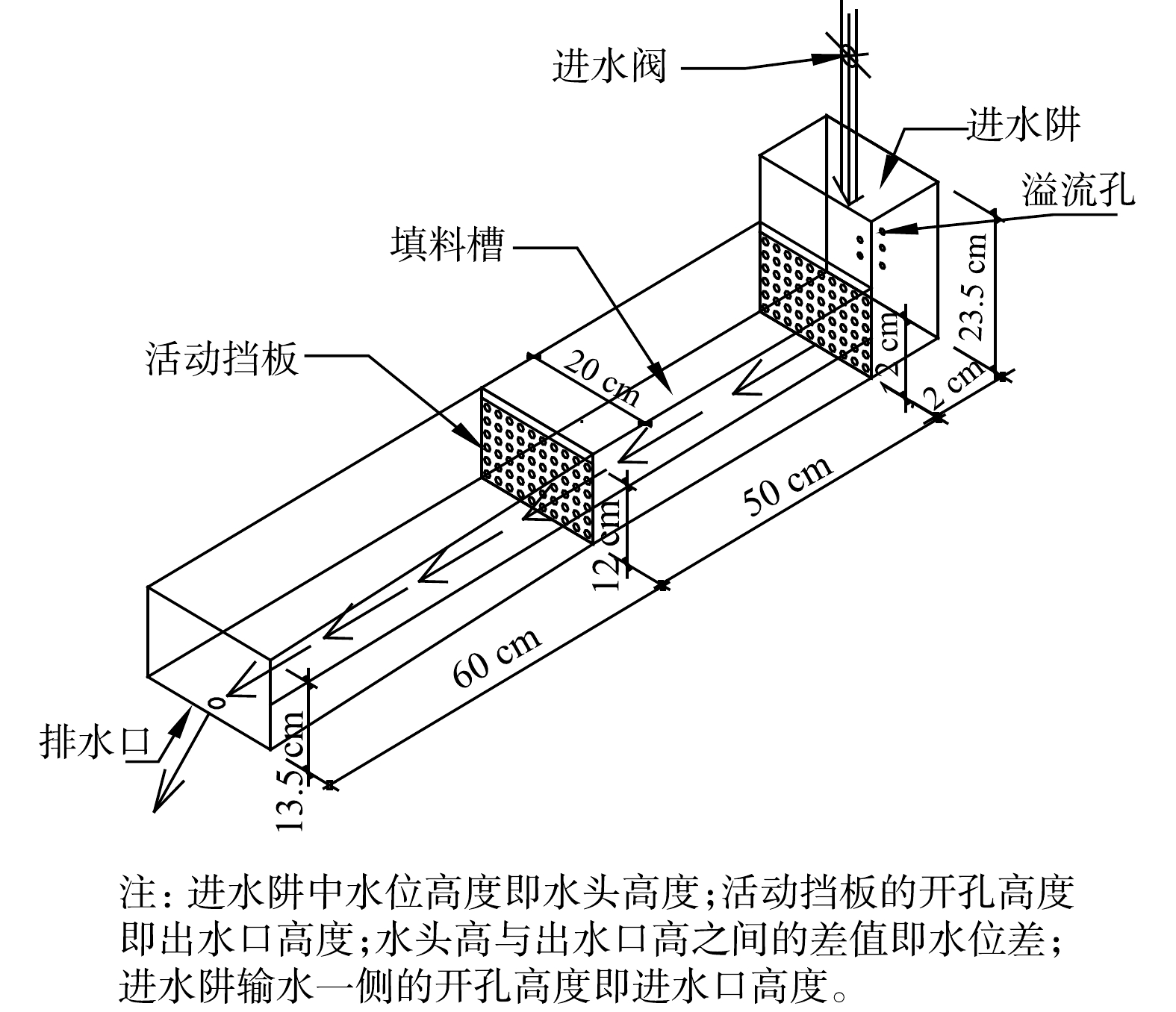
 下载:
下载:


















